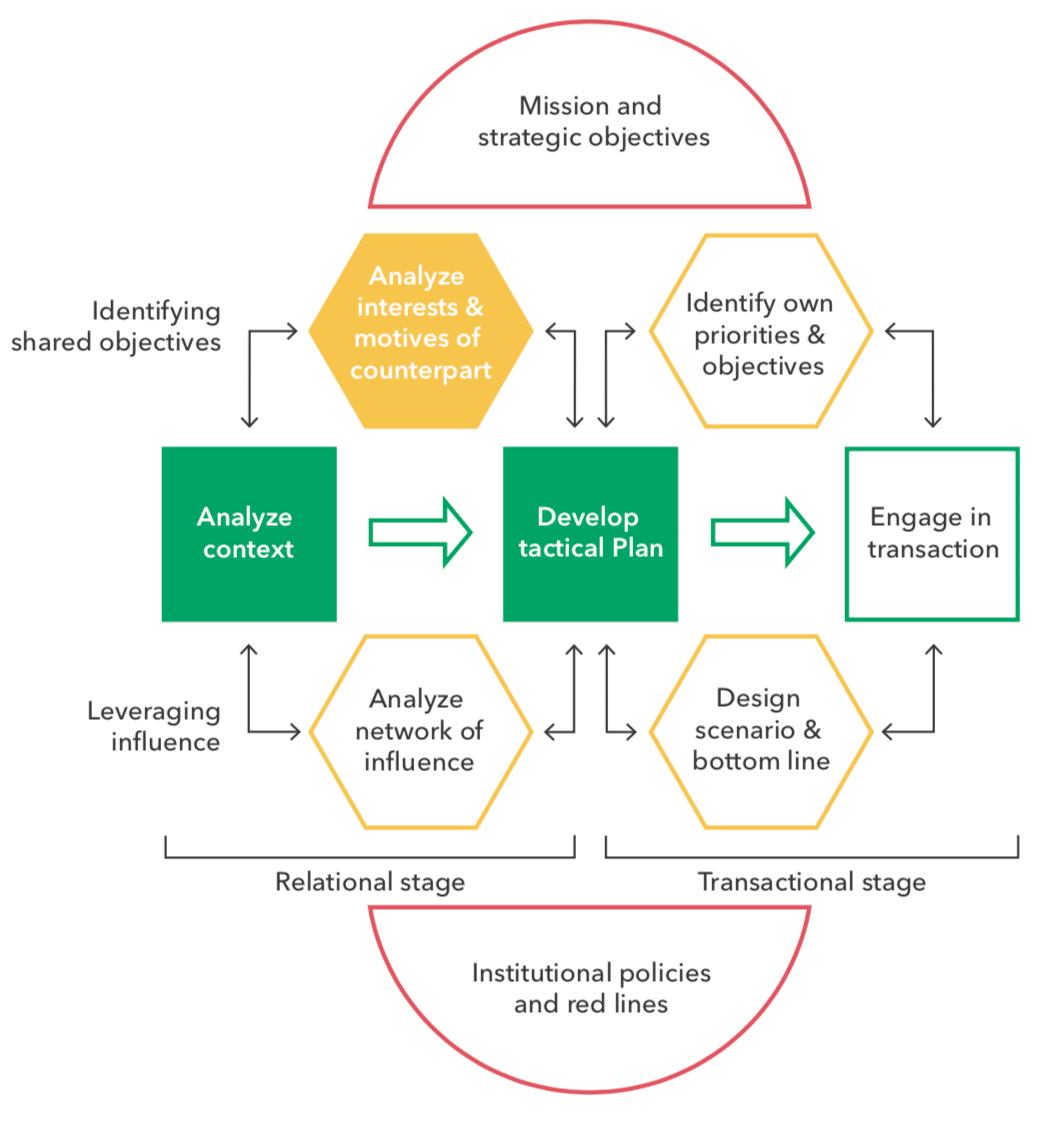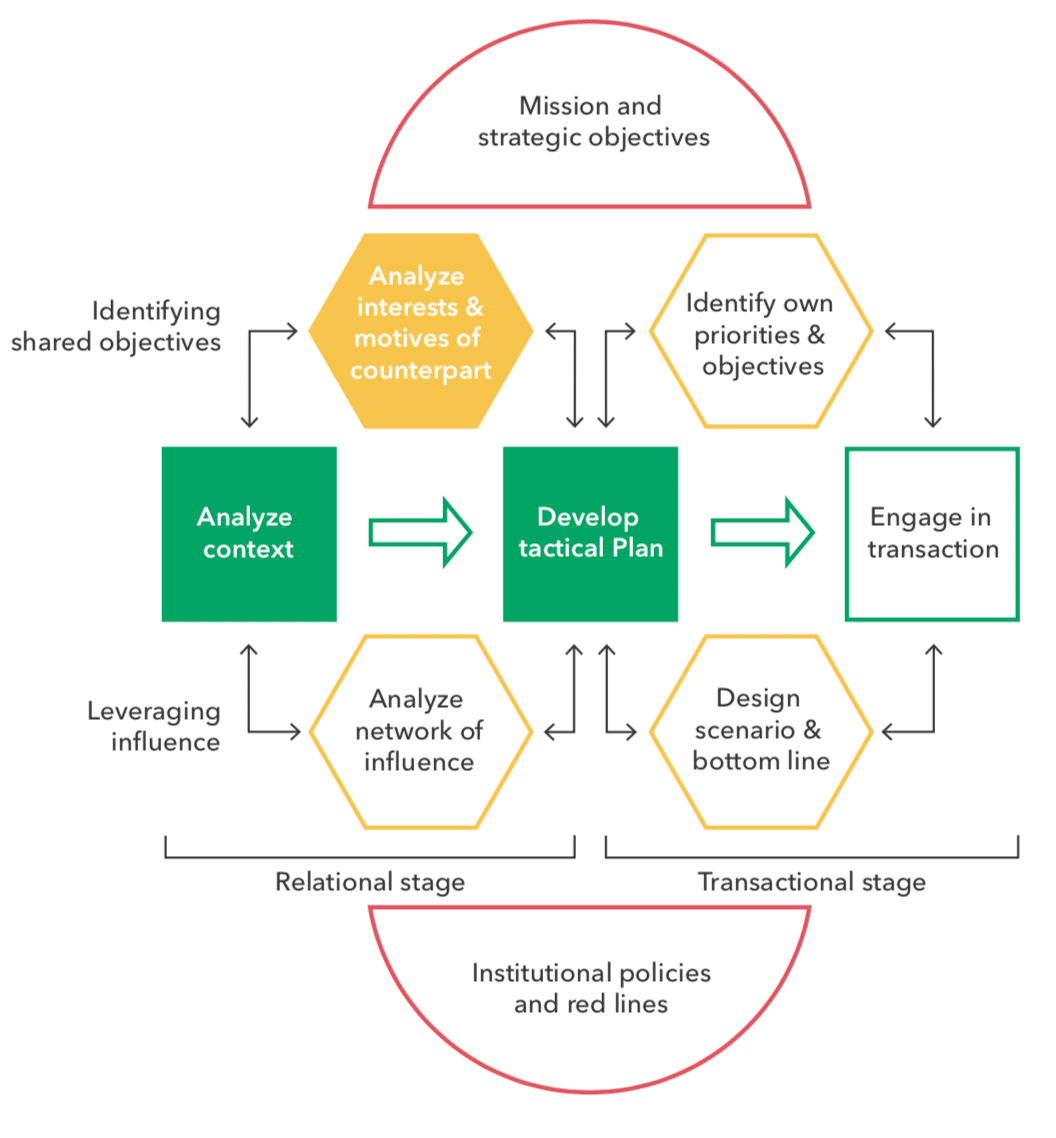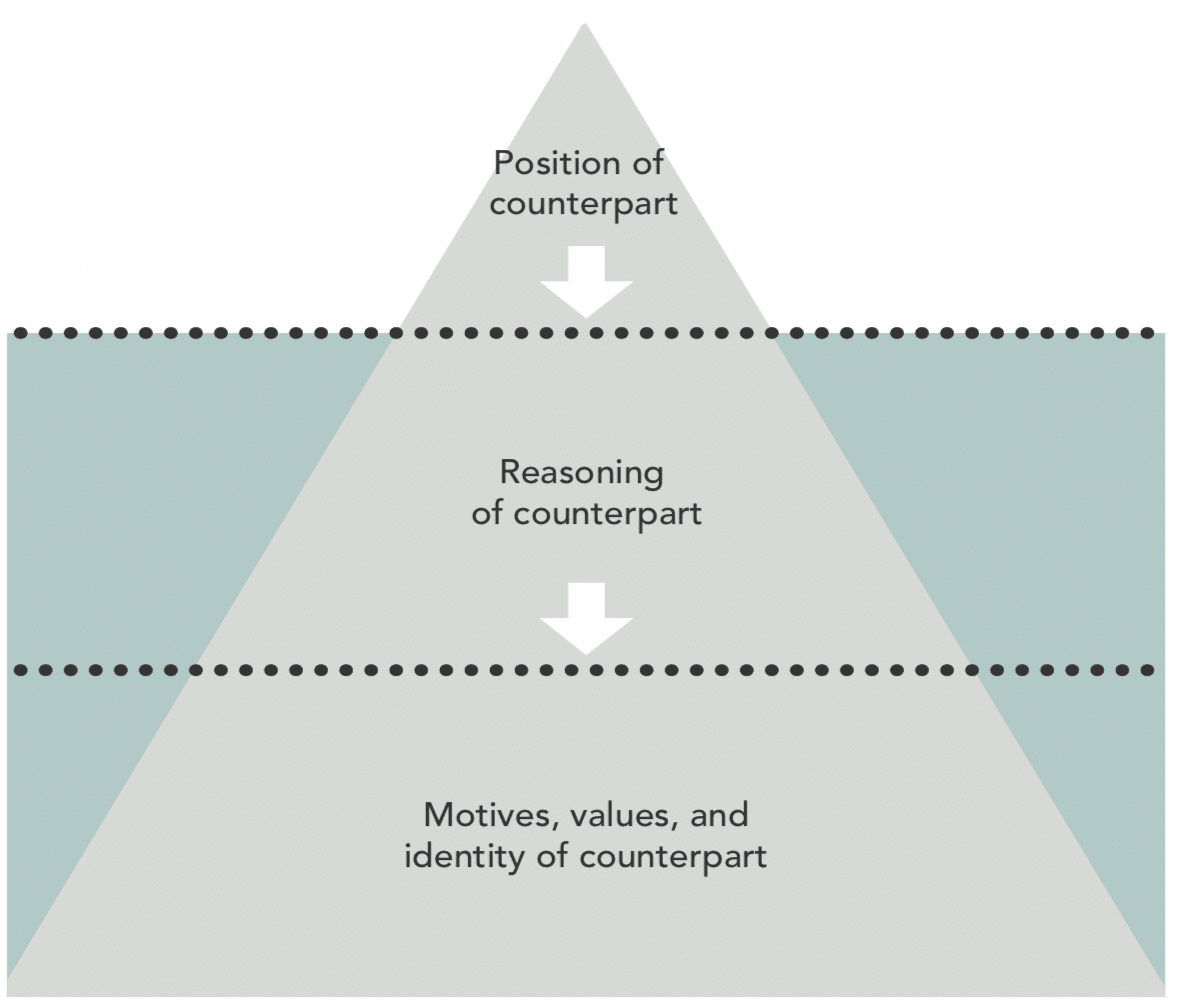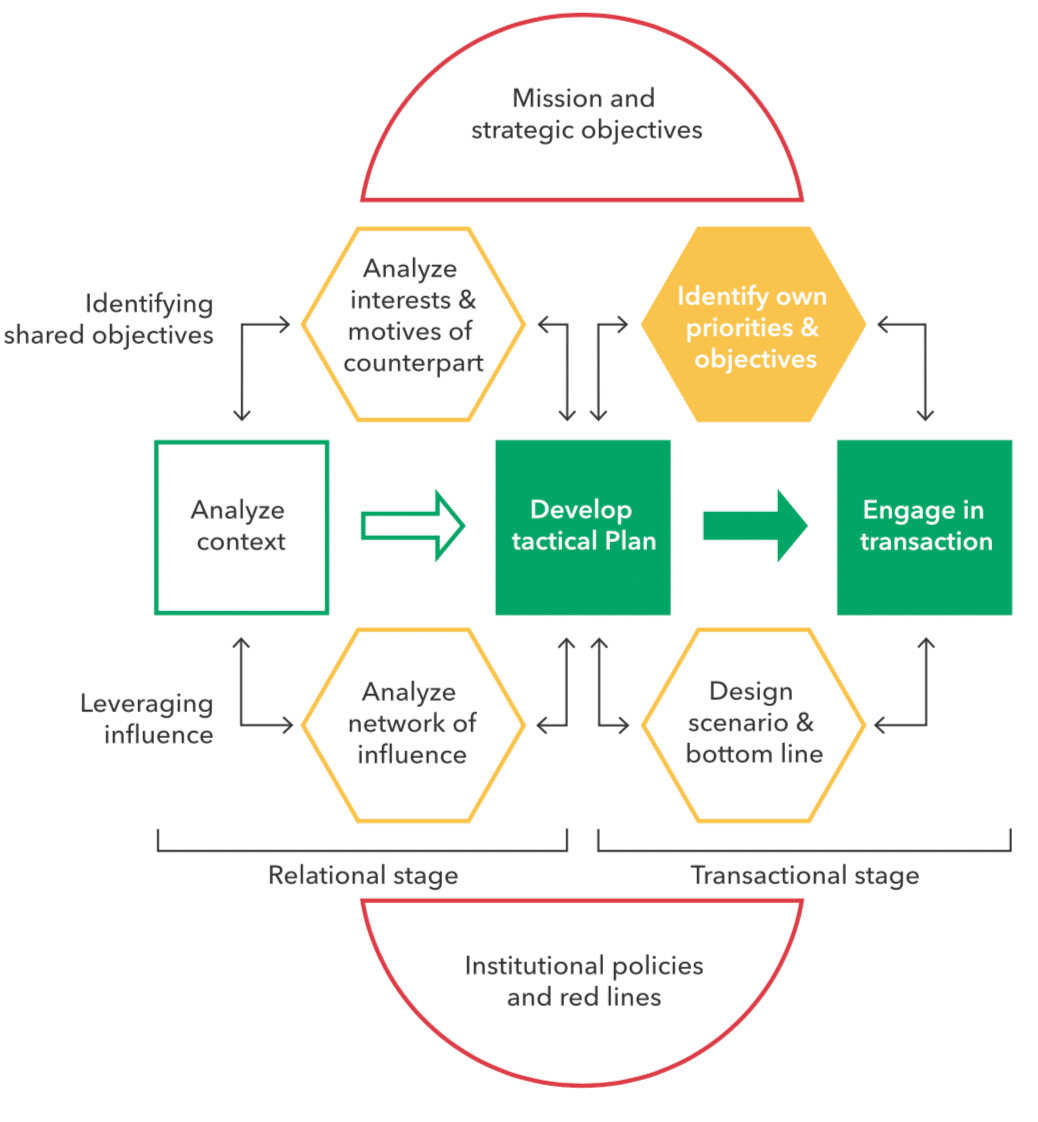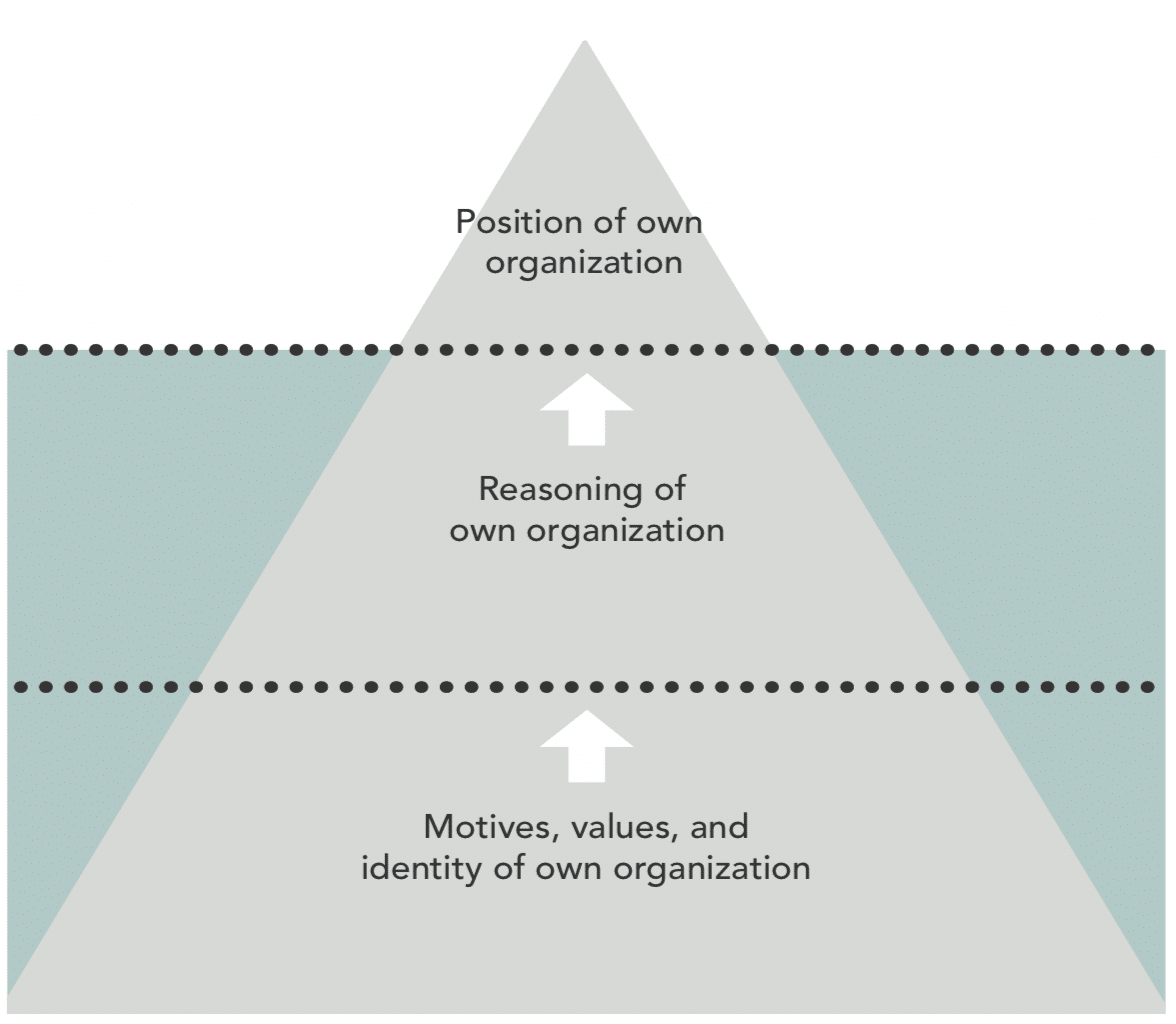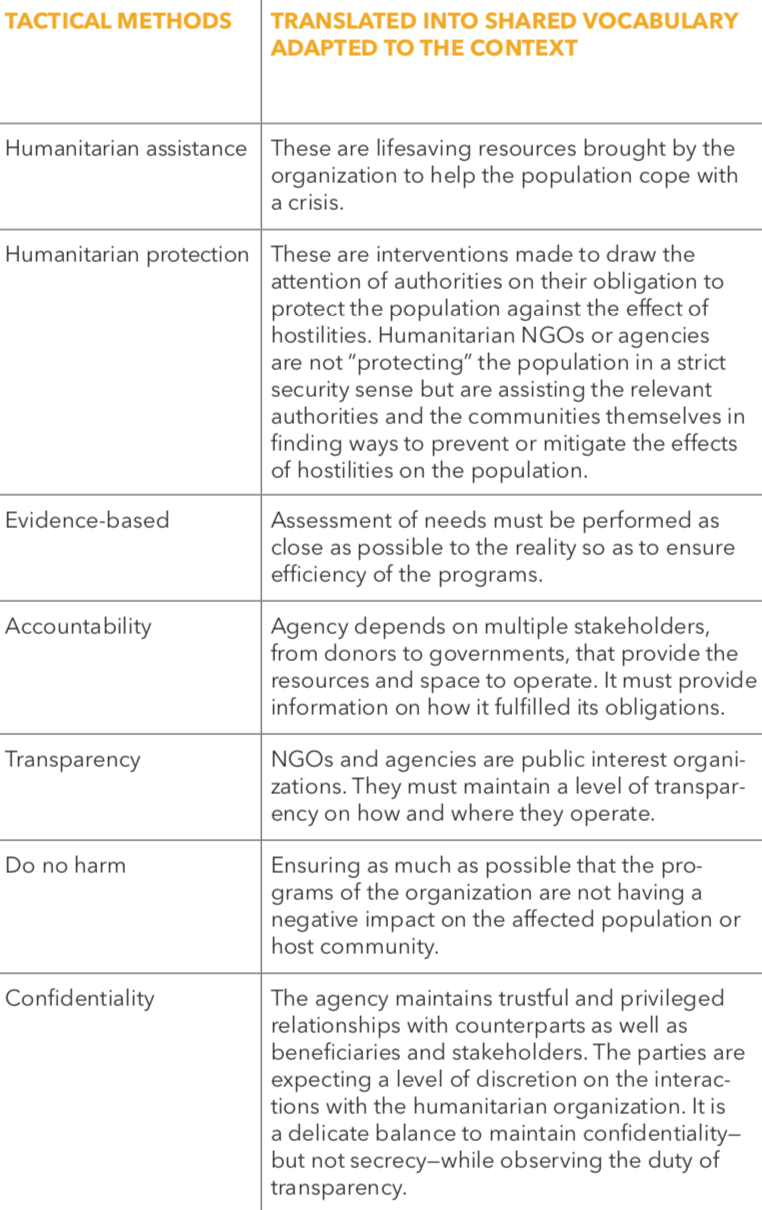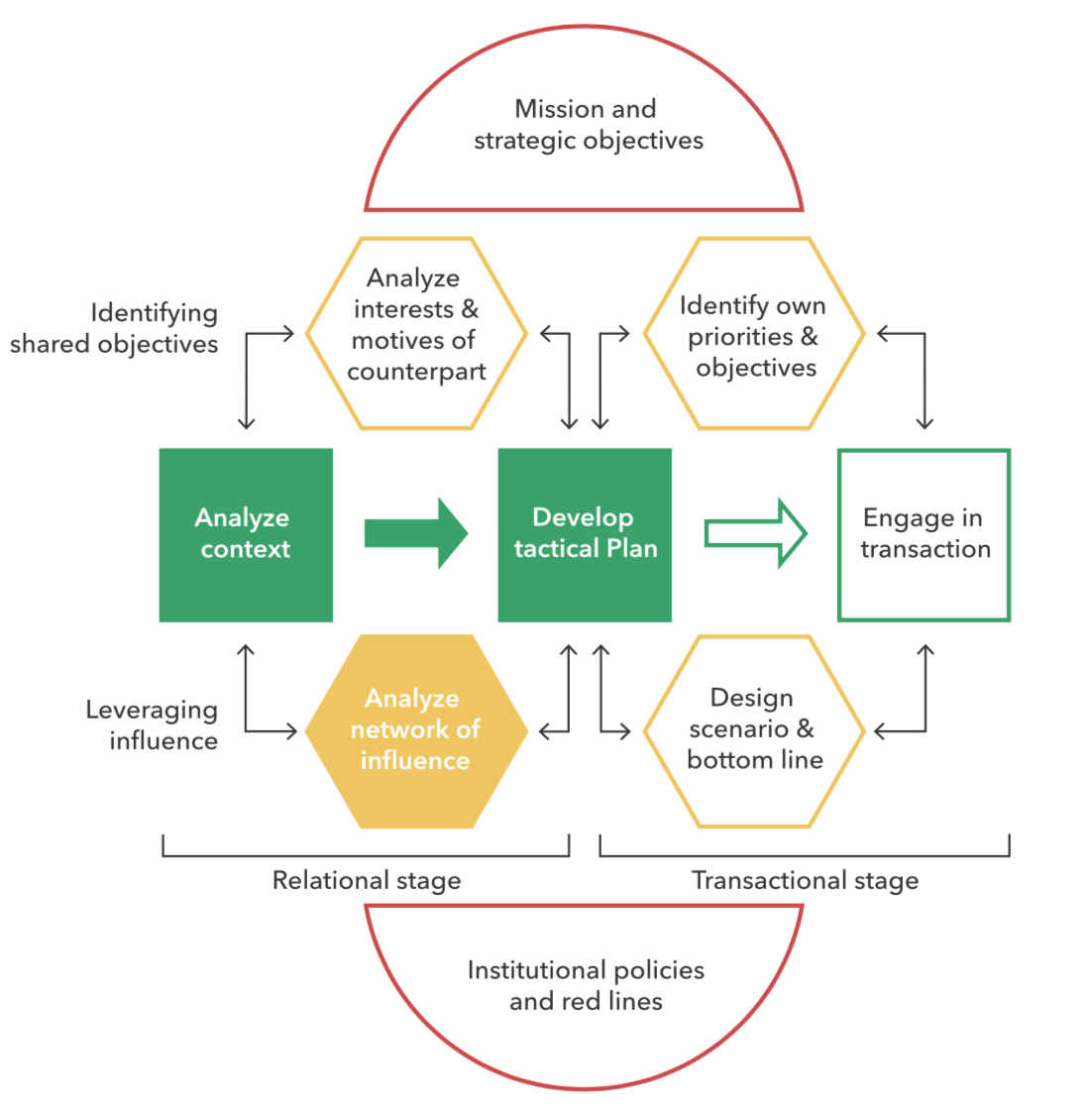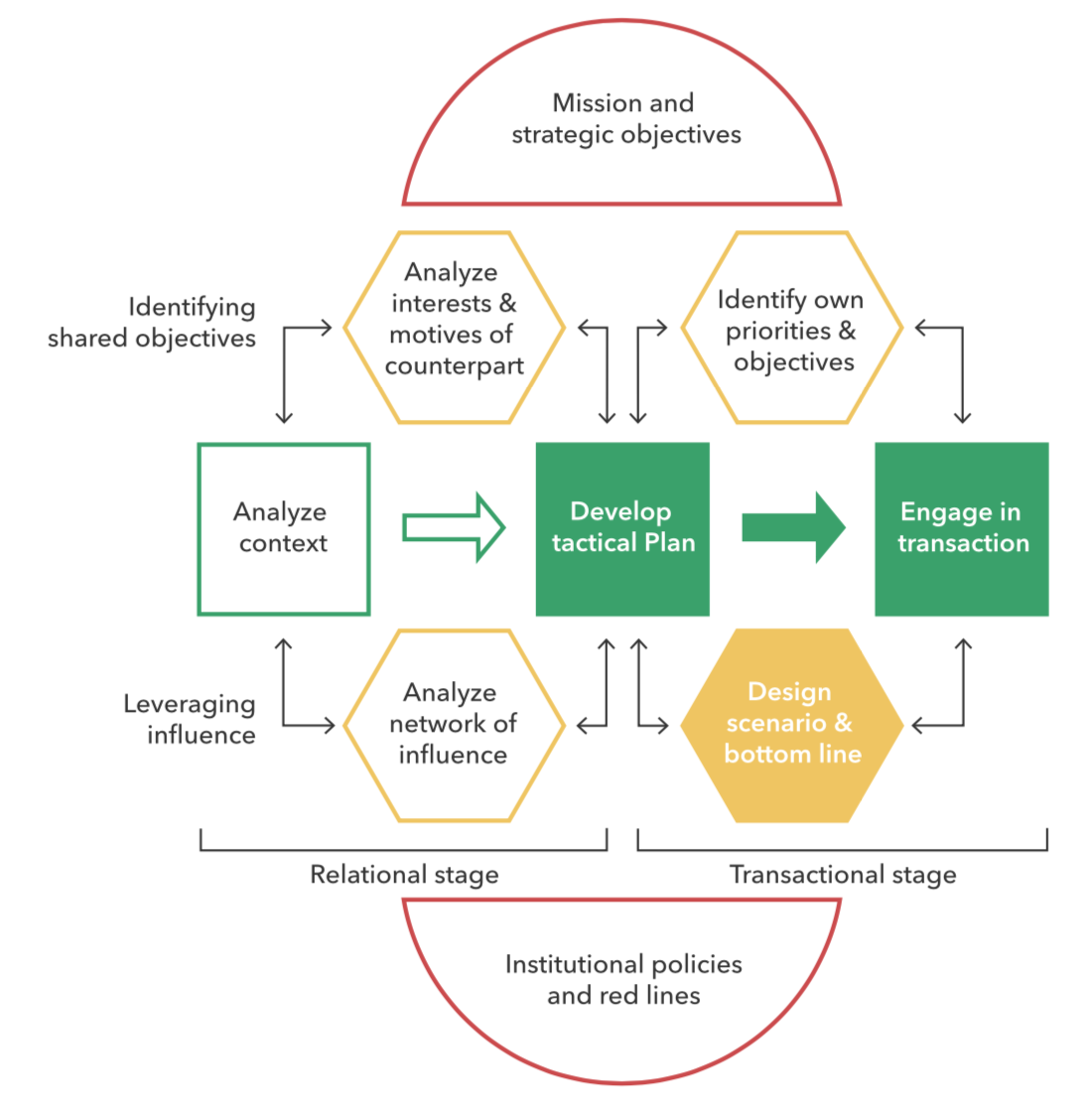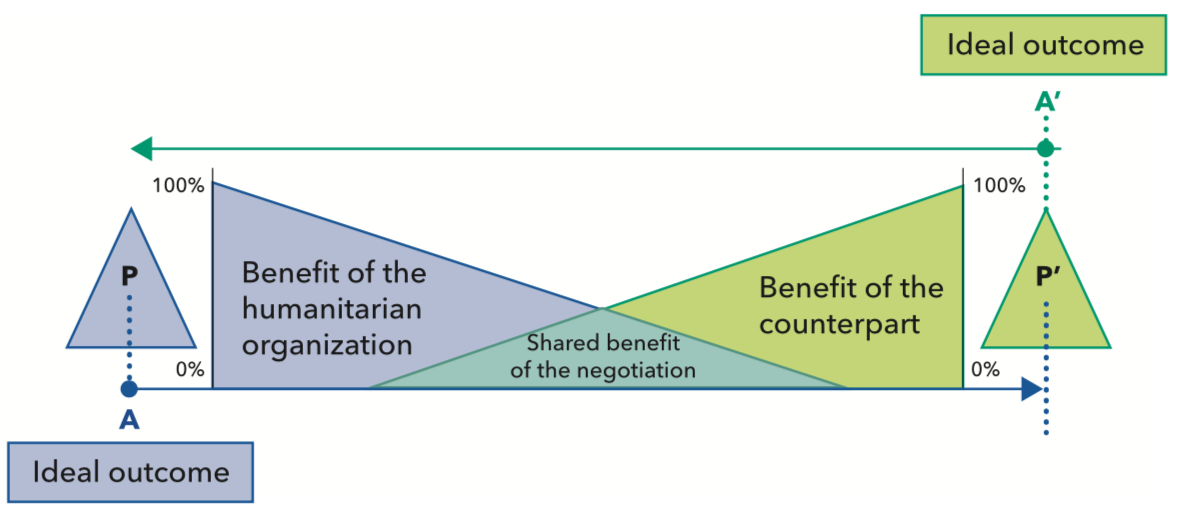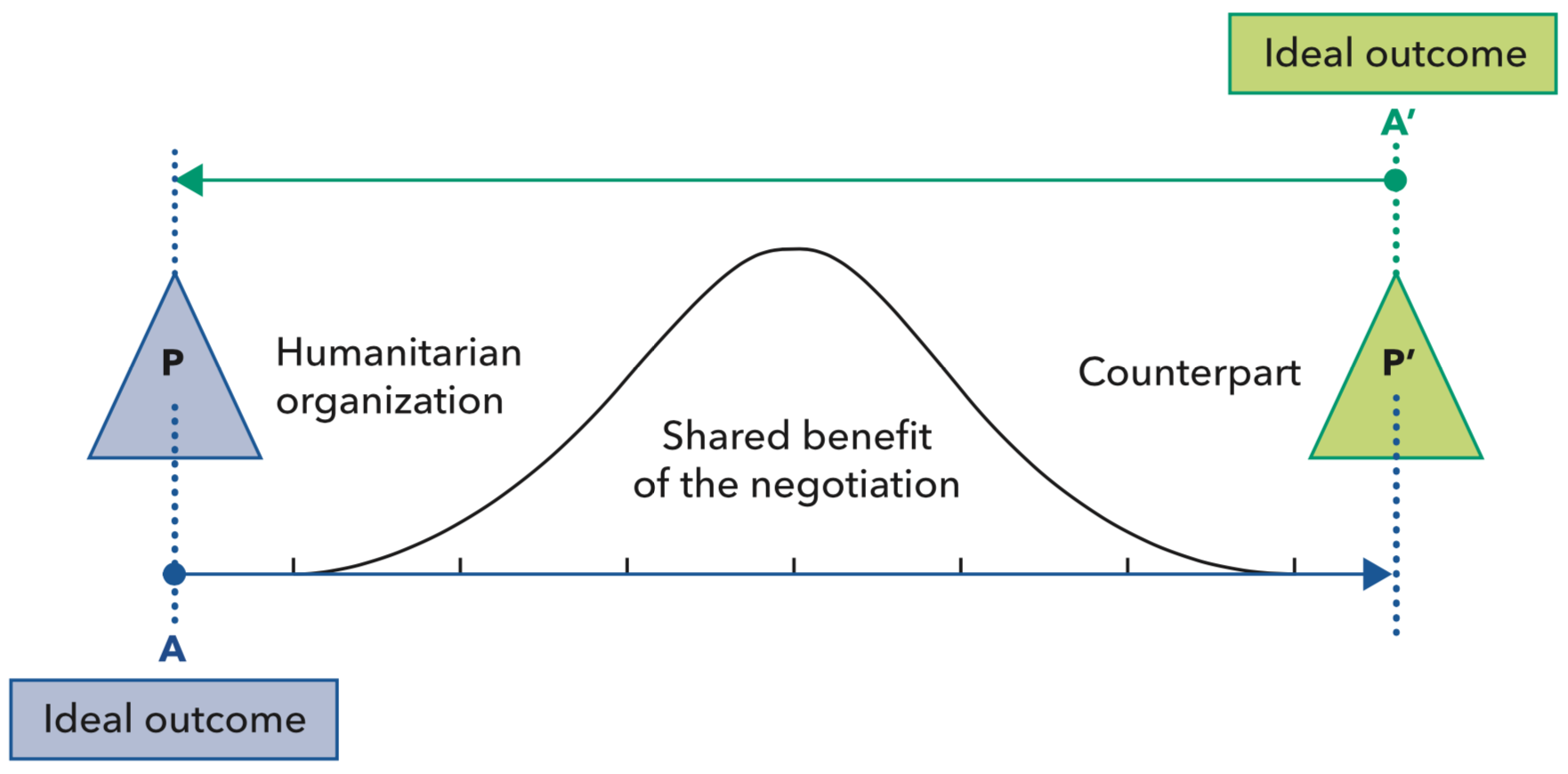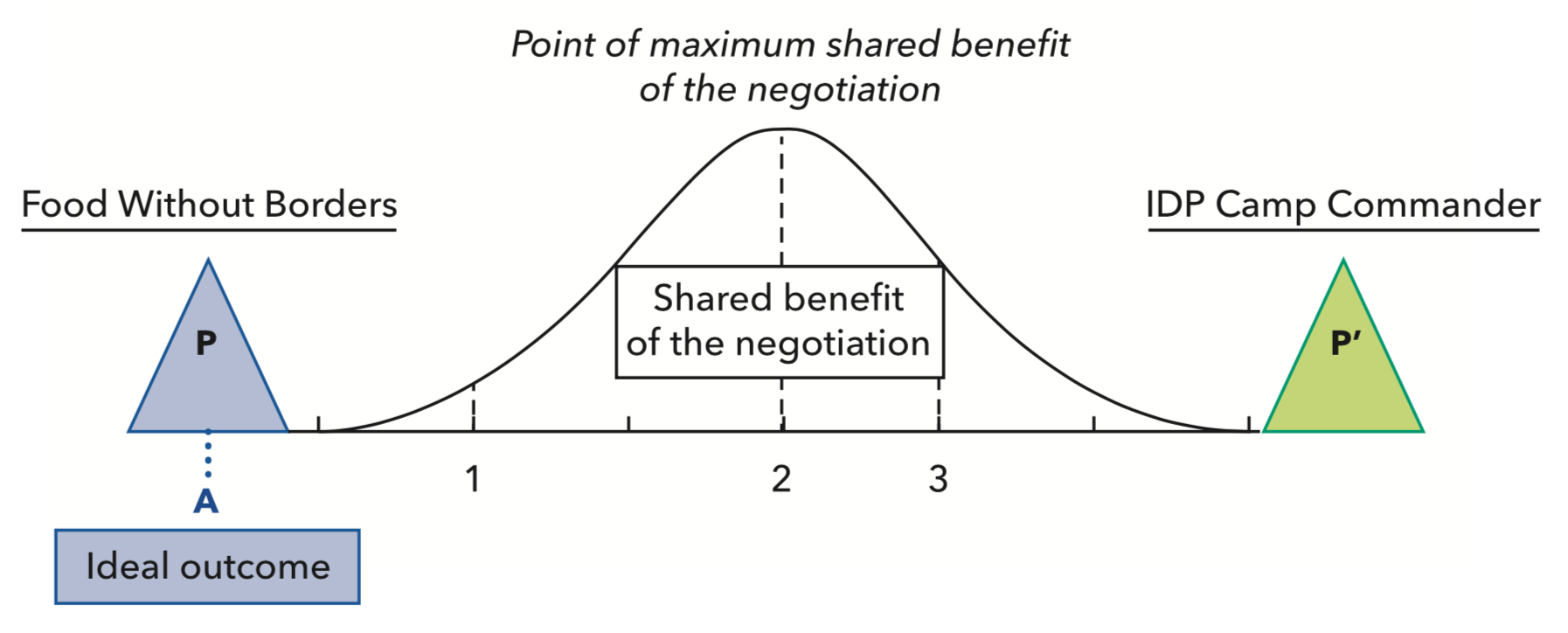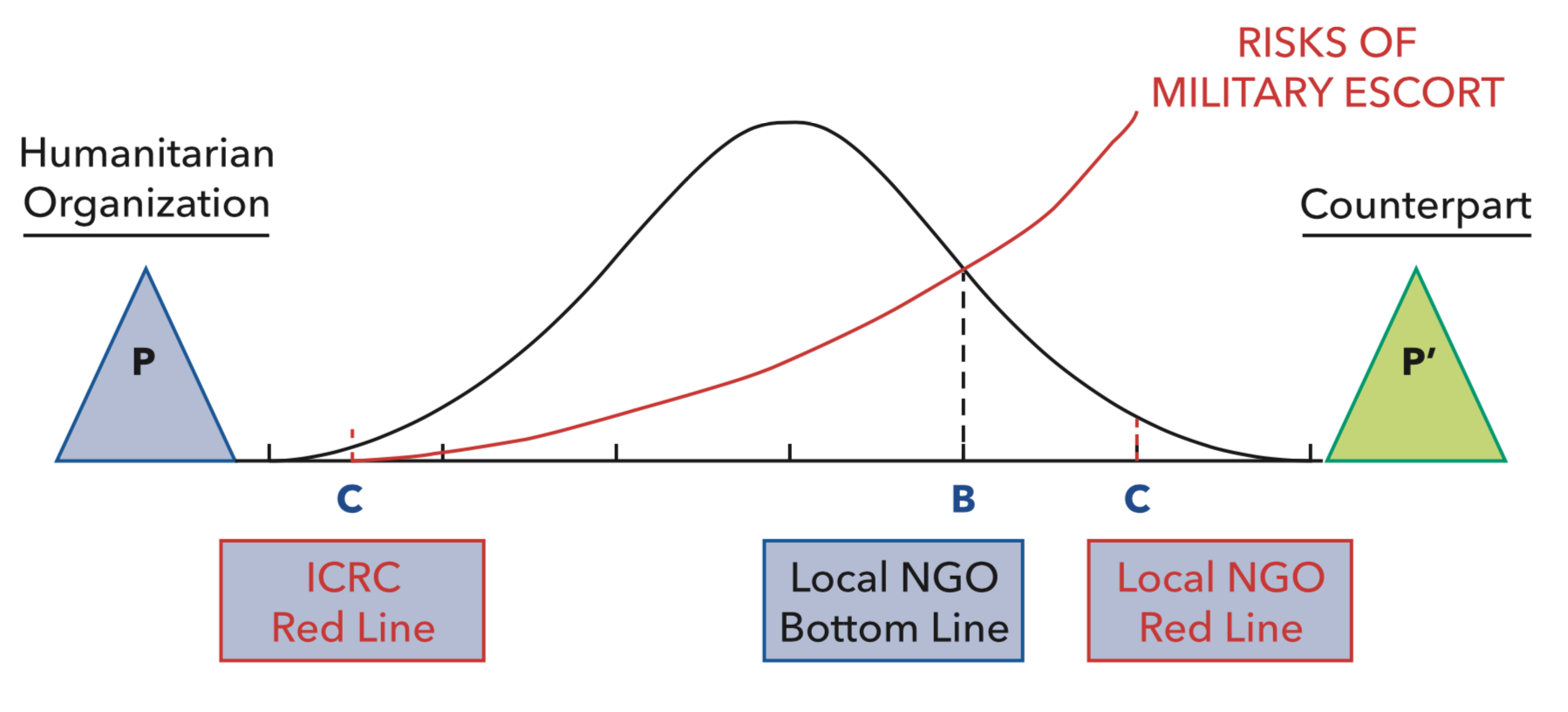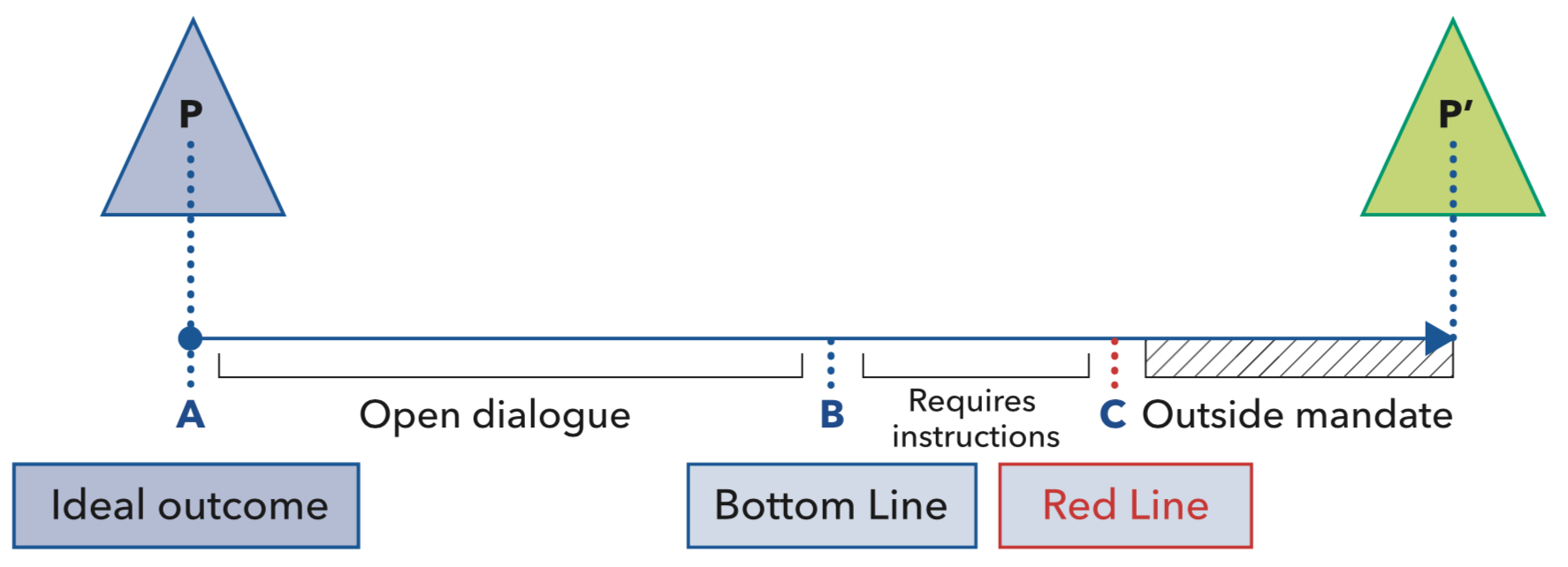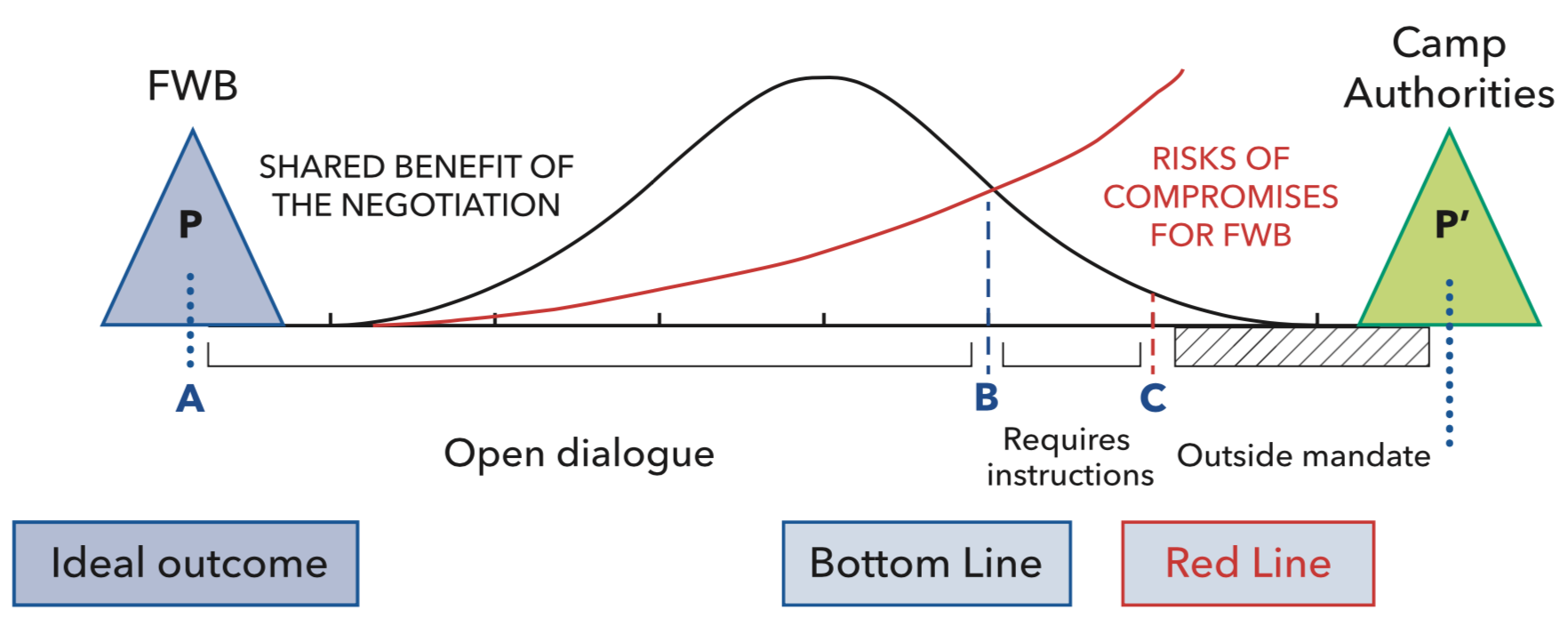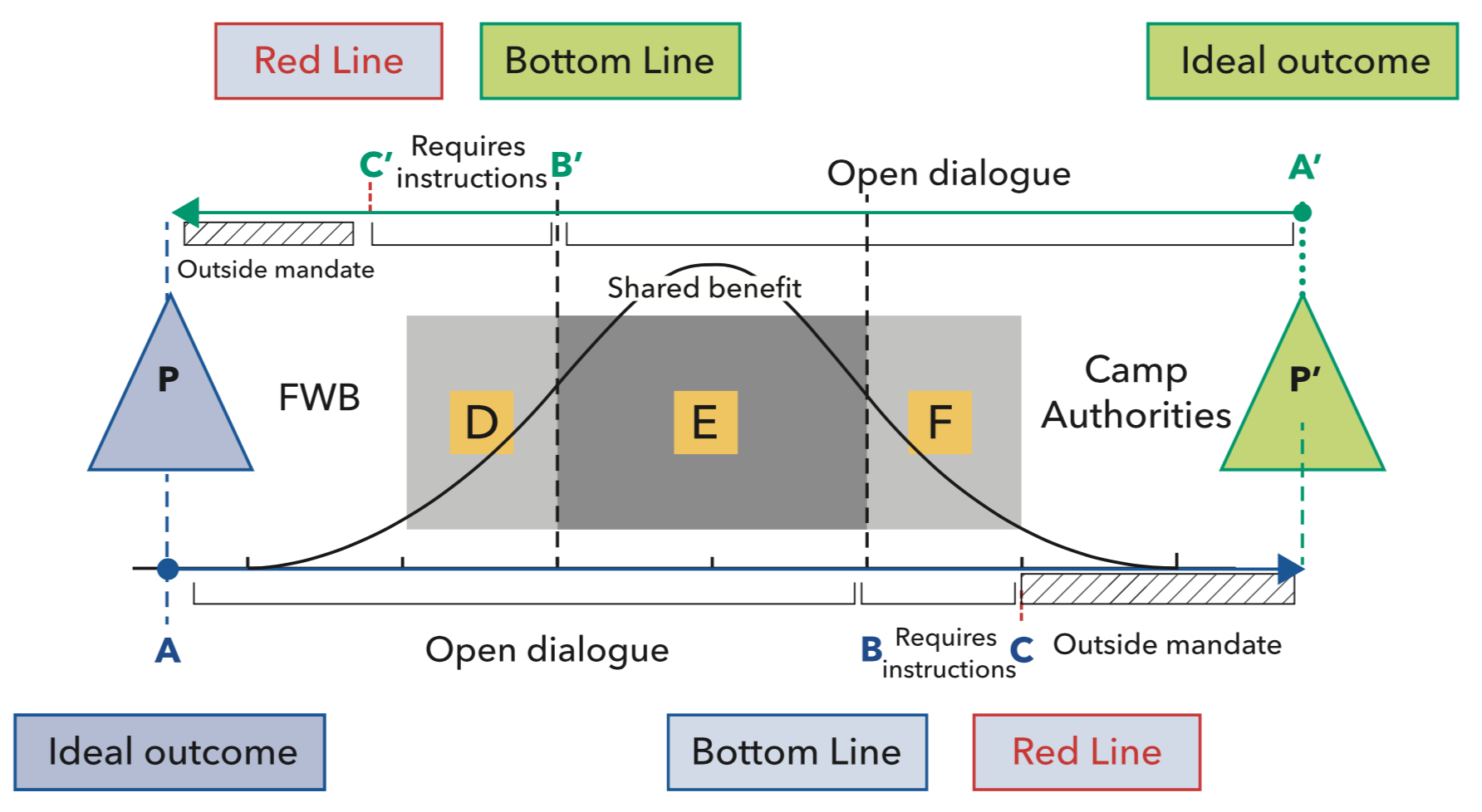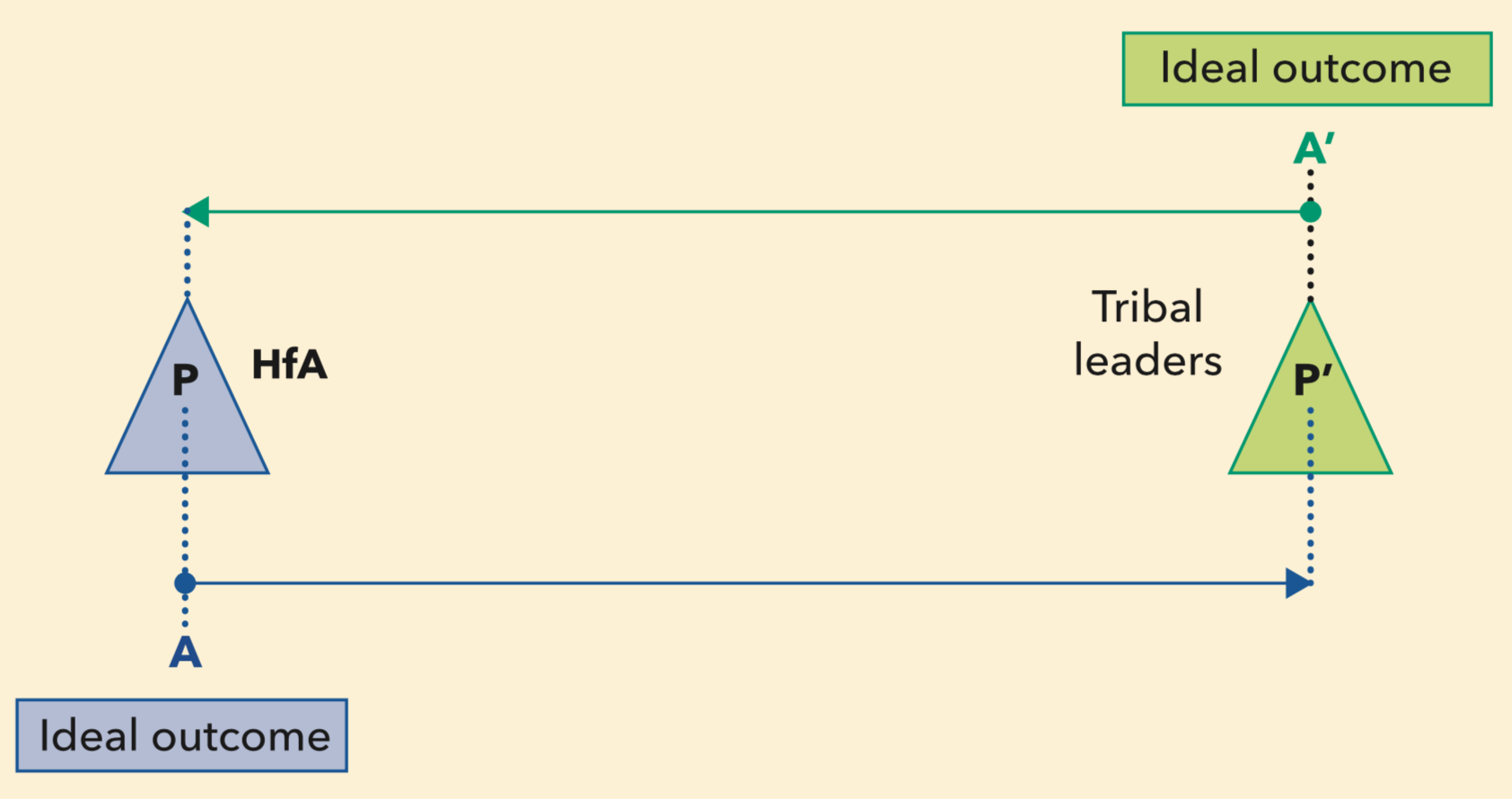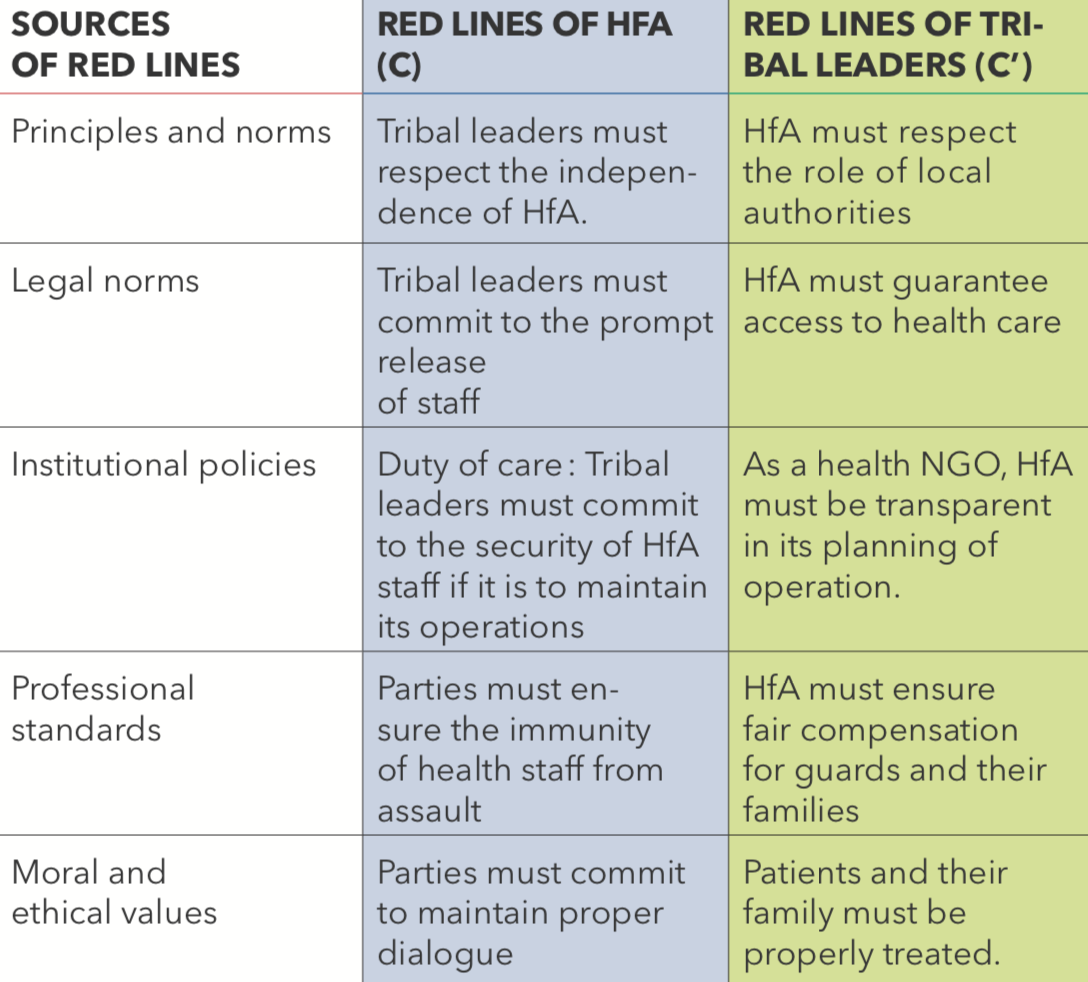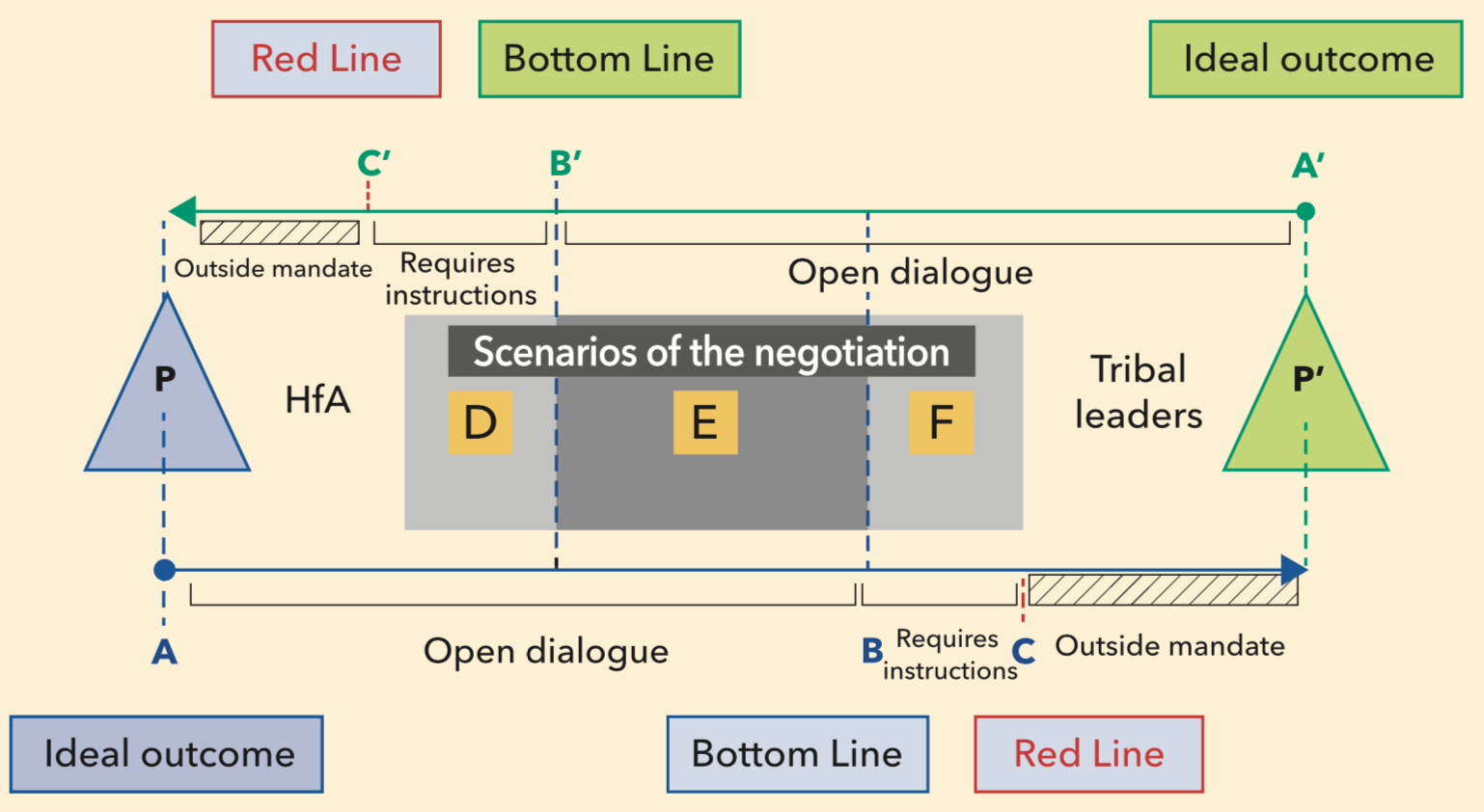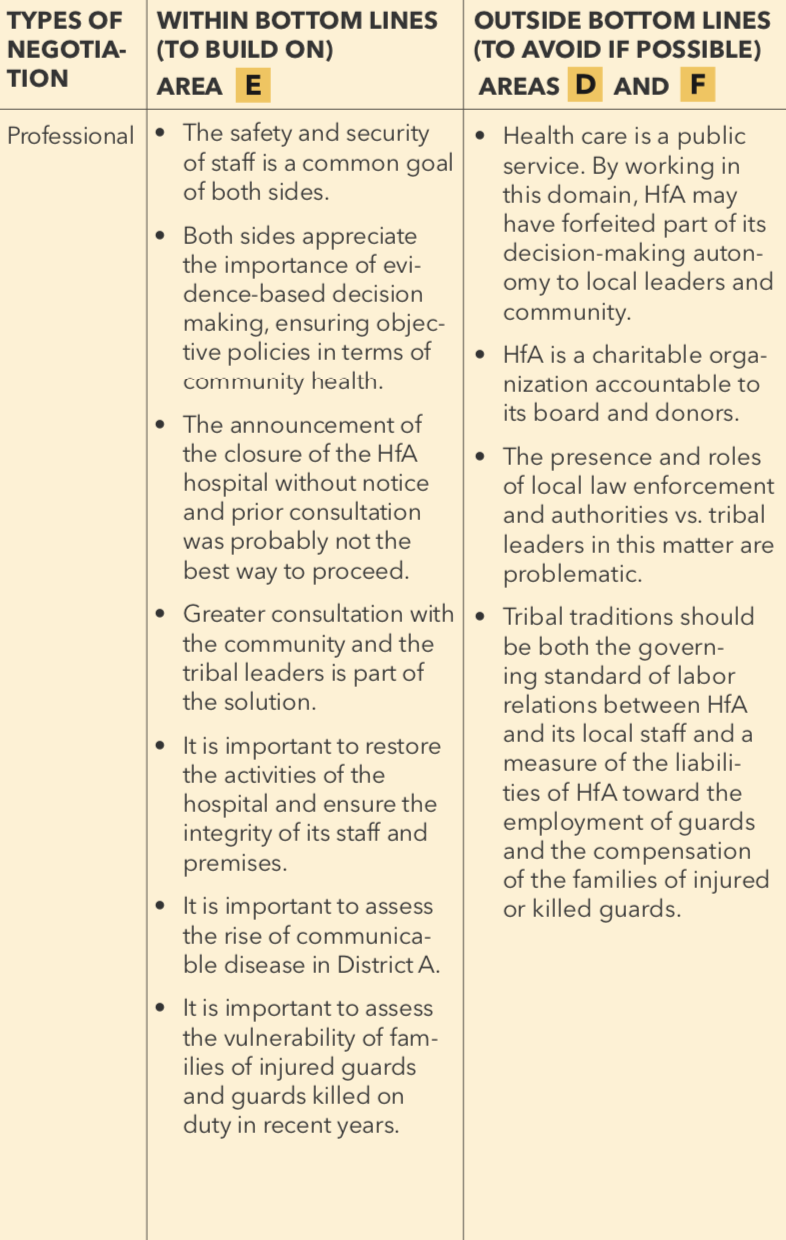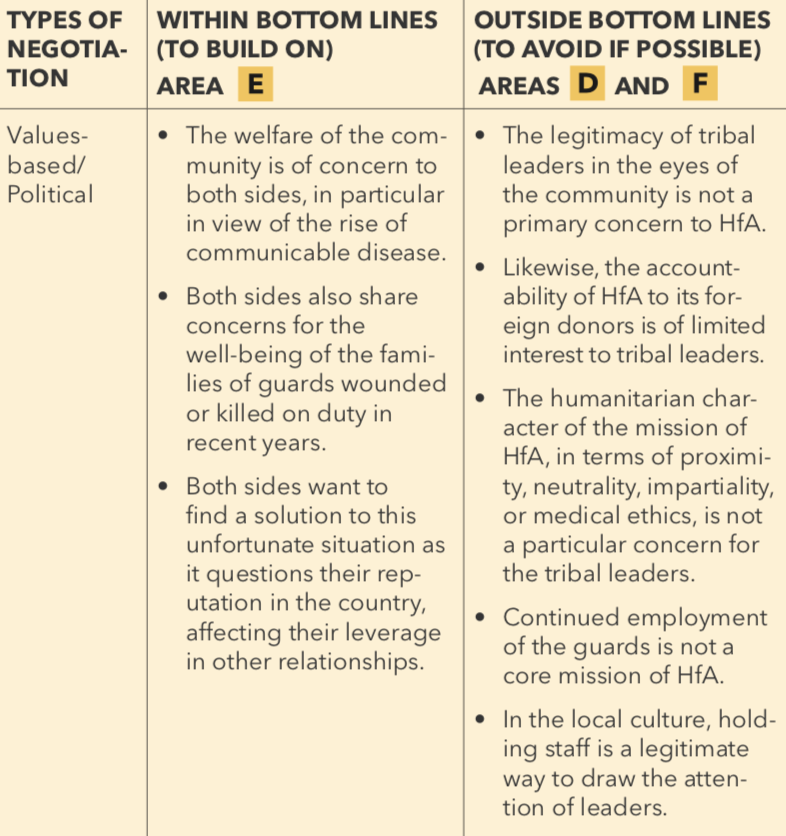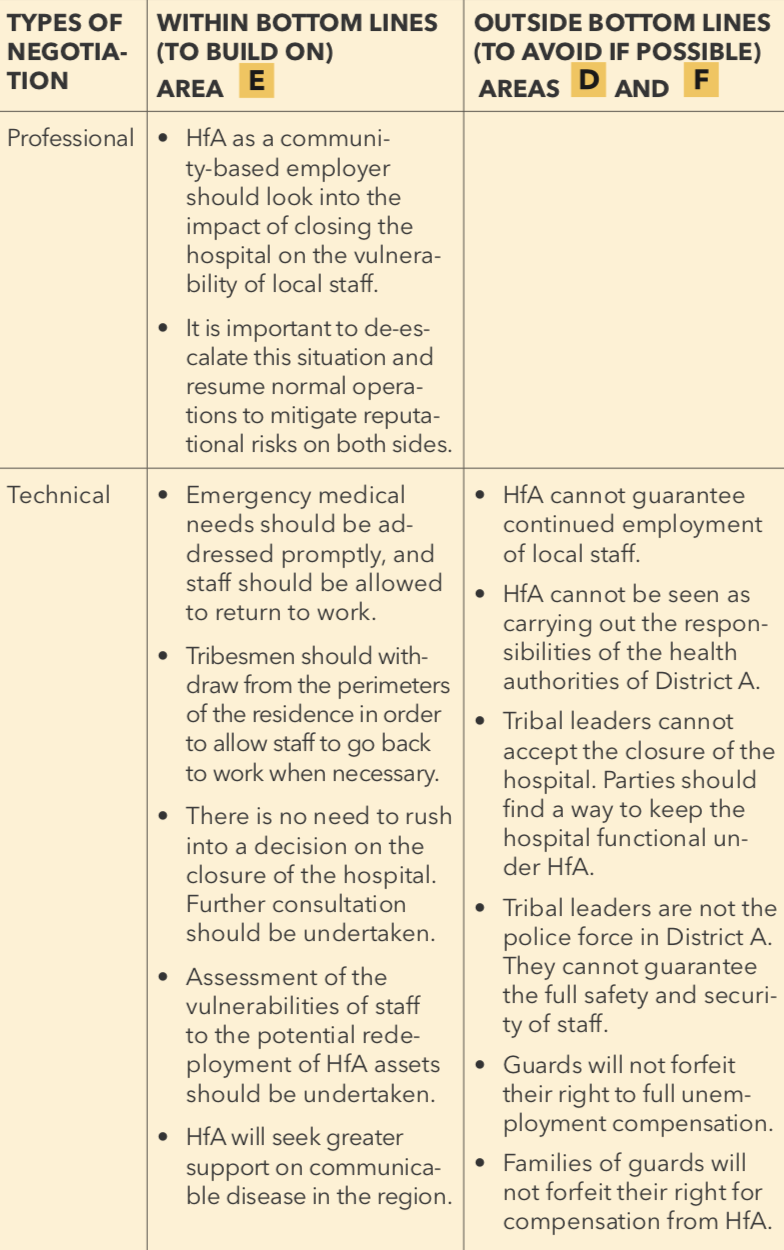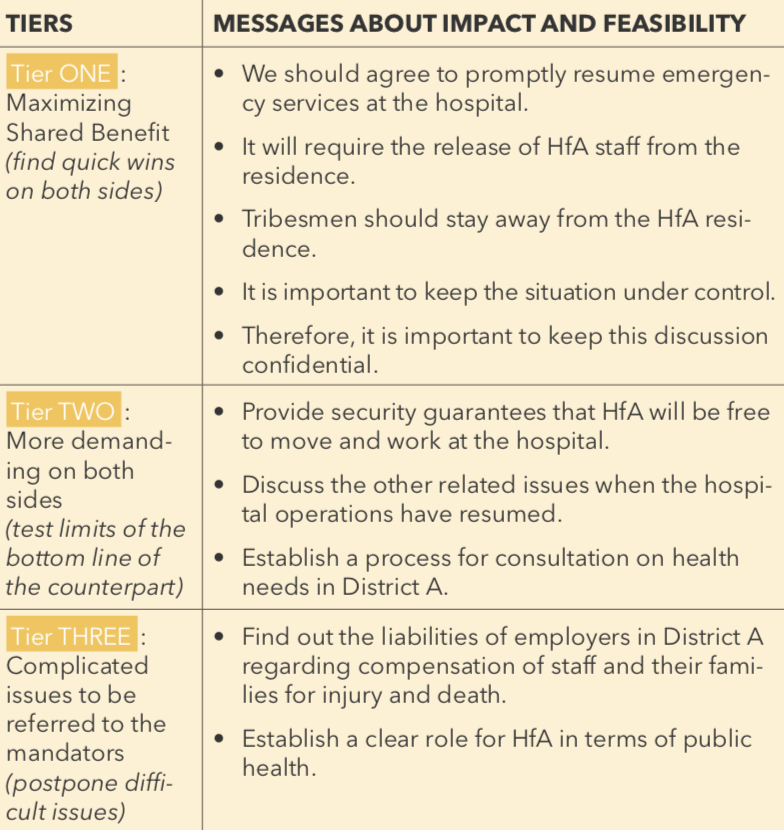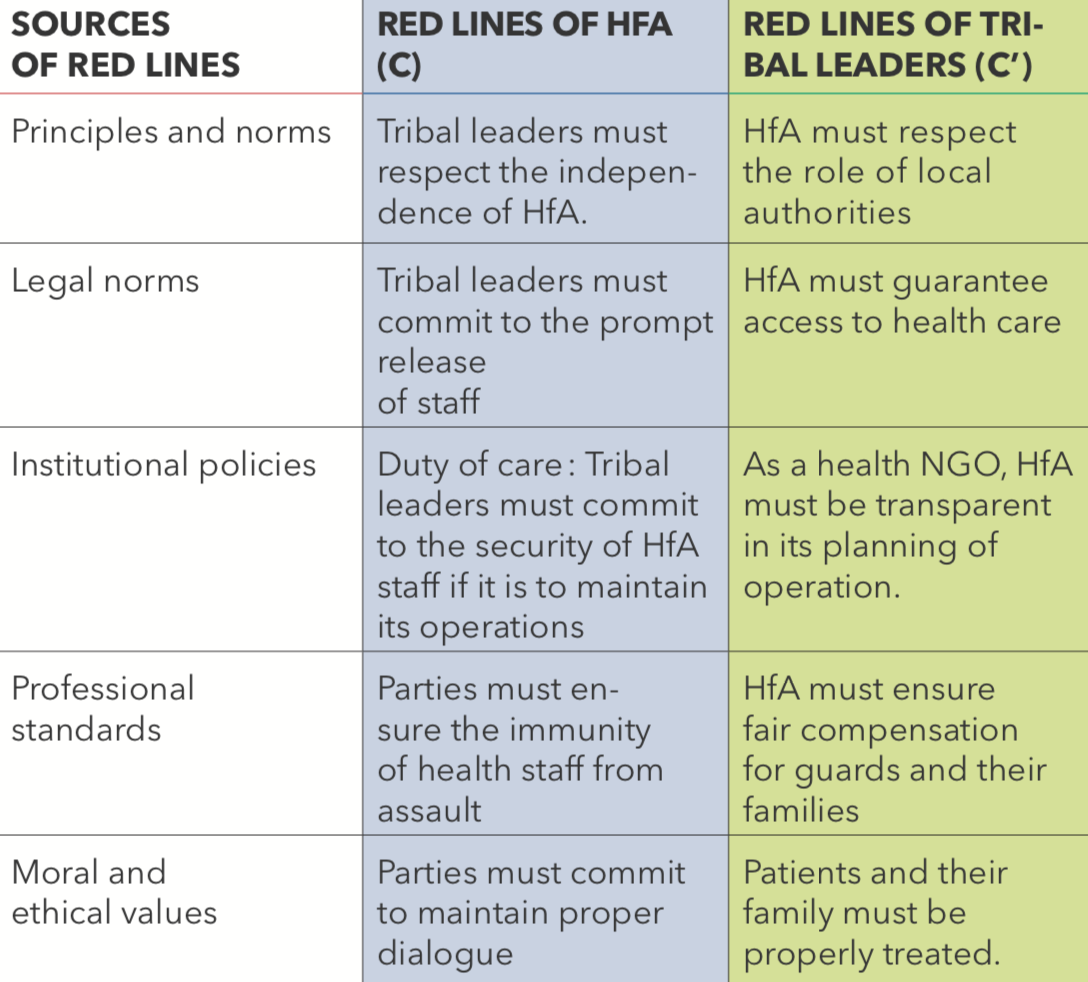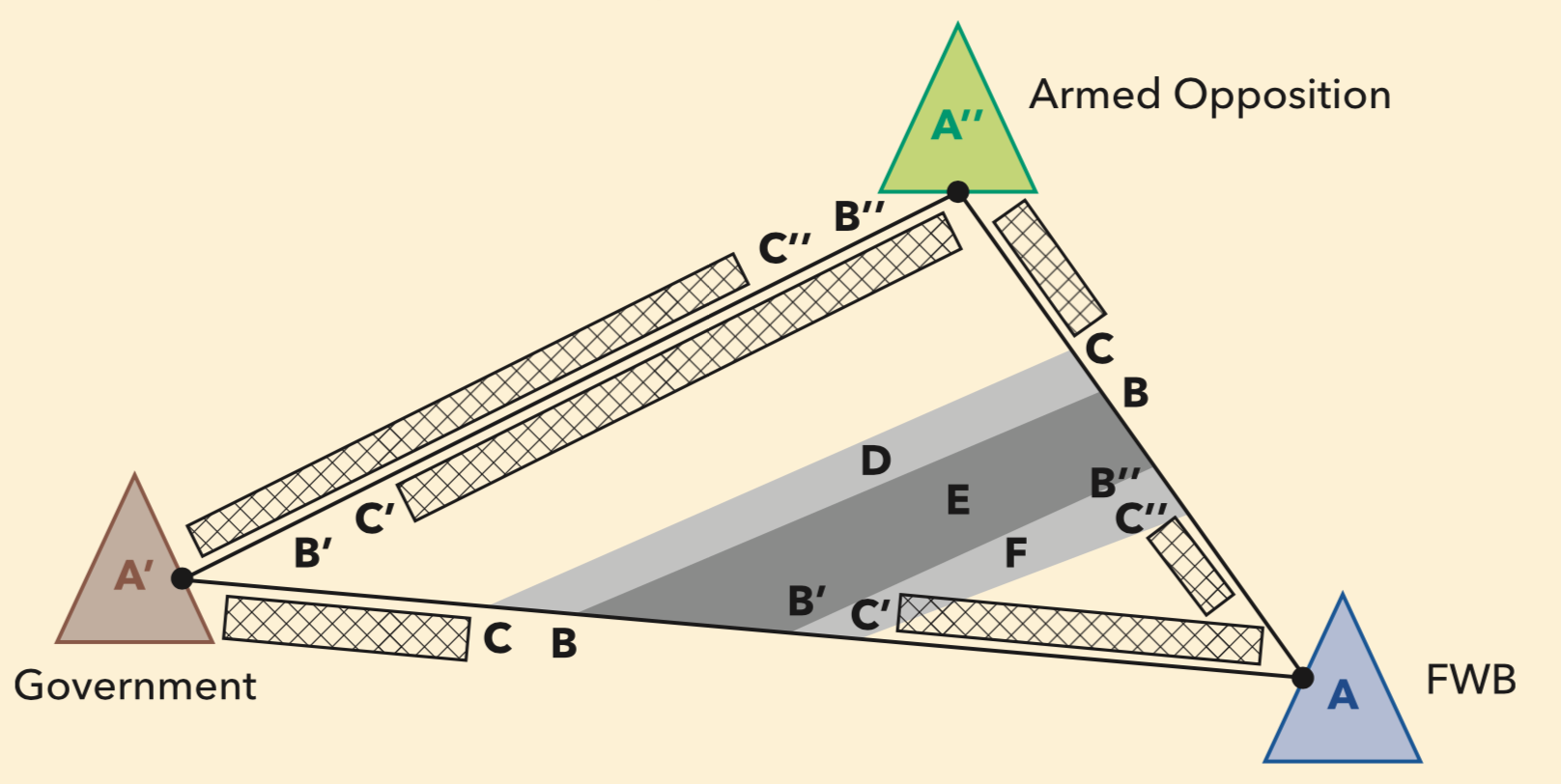Resources
Field Manual
Introduction
The objective of this section is to provide a framework for the colleagues of the frontline negotiator to assist and support the development of the negotiation strategies and tactics.
Frontline negotiation is understood across the humanitarian community as a relational undertaking involving the humanitarian negotiator and his/her counterpart(s) in a search for common grounds to ensure the provision of essential assistance and protection to populations in need. The relational character of this activity is seen by practitioners as a core element in building trust between individuals and organizations in situations of armed conflict and violence. Building on their personal connection, negotiators on both sides are able to ascertain their shared interests to drive the negotiation process forward.
One side effect of this personalization of the relationship is that decisions on the orientation of the negotiation process are often made primarily by those negotiators involved at a personal level. Humanitarian negotiations can easily turn into private dealings if the process is not integrated into a professional and critical endeavour, as the scope of interests and the stakes at play are usually much larger and more far-reaching than the ones envisaged by the individuals in their relationships. The larger picture may have considerable implications in terms of the lives and dignity of thousands of people, as well as the reputation, safety, and security of a whole organization.
Humanitarian negotiations are team-based, comprising the frontline negotiator who leads the engagement with the counterpart, the negotiation support team who assist in the critical reflection on the orientation of the process, and the mandator who frames the process into the institutional policies and values.
The team-effort model is an effective way for solo practitioners to maintain their autonomy as frontline negotiators while making a responsible and professional decision to open a critical collaborative space around them in the planning process of the negotiation. The deliberation within the support team aims to ensure the maintenance of the required critical space to define and regularly review the objectives of the negotiation process and inform the design of the tactical plan (see Figure 1).
These deliberations primarily engage the humanitarian negotiator who is responsible for driving the negotiation process (see 1 | The Frontline Negotiator) and team members and peers who are closed to him/her. The due diligence process among professionals involves sharing their views on critical orientations where emotion, frustration, and stress can play a detrimental role. This practice also provides an assurance to the mandator—the hierarchy of the organization—that tactical choices are made deliberately, i.e., with consideration of different options and perspectives.
This section will examine successively a proposed set of tools to:
- Analyze the position, reasoning, and values of the counterpart regarding the object of the negotiation;
- Identify specific priorities and objectives of the negotiation process;
- Design scenarios, bottom lines, and red lines to frame the negotiation process; and
- Assess the network of actors who may influence the position of the counterparts.
These practical tools should serve as background elements to guide internal discussions between the frontline negotiators and the negotiation team.
Introduction
The purpose of this segment is to analyze the underlining reasoning and motives of the counterpart that may explain the position of the parties in a negotiation process. This analysis builds on the assessment of the political, social, and humanitarian context.
The analysis of the position of the counterpart(s), as well as the understandings and perceptions of the constituency of the counterparts, will inform the development of the position of the humanitarian organization and facilitate the design of the tactical plan by its negotiation team (see 2 | Module B: Identifying Your Own Priorities and Objectives). They will help to identify points of convergence and divergence between the positions of the parties related to a specific negotiation. This assessment will further inform the type of negotiation to be envisaged—whether political, professional, or technical in nature—and the selection of the skills required—conciliation skills, consensus-building skills, or specific technical abilities (see 1 | Module B: Tactical Plan).
Tool 9: Analyzing the position of the counterpart
A negotiation process entails from the outset various points of convergence and divergence between the parties—some may be explicit, others may be more implicit. To prepare for the negotiation process, the humanitarian negotiator should draw his/her tactical plan on a solid understanding of the position and perspective of the counterpart on the given issue and in a given context. This preliminary assessment aims to understand the framing of the position of the counterpart in a holistic and non-judgmental manner. The goal is to avoid focusing too early on the points of divergence and try to elucidate the counterpart’s inner reasoning and inner motives, especially in terms of loss, fear, and grievances, as these elements are major drivers of positions in frontline negotiations.
Based on the information gathered in the course of the context analysis, the main questions are therefore:
The starting position of a counterpart is generally based on a logical reasoning that reflects its tactical interests and a set of intrinsic values and norms that are at the core of its identity. The discussions at the negotiation table tend to evolve between these levels.
Here are some examples to illustrate the levels of the discussion.
What does the counterpart want?
- In response to a request from Health for All (HfA), an international NGO, to open a clinic in Country A, the Minister of Health communicated the Ministry’s starting position that HfA needs to obtain a license from it to operate the clinic.
How did the counterpart get to this position?
– Based mostly on logical reasoning (a fortiori):
- The Minister of Health requires HfA to obtain a license from the Ministry before it starts operating in the country, as HfA would do in its country of origin.
– Based mostly on legal/professional reasoning:
- A license to operate in Country A is required under national law applicable to all medical NGOs. The reason for the license is to ensure the respect of professional medical standards in Country A. Failure to comply may generate legal liabilities for HfA and its representatives.
Why does the counterpart take such a position?
– Based mostly on value-driven motives:
- The Minister of Health orders the representatives of Health for All to respect the national sovereignty of Country A by subjecting all international NGOs to the law of the land. Failure to comply with licensing requirements will be considered an unacceptable intrusion by HfA into the internal affairs of Country A.
Depending on the assessment of the roots of the position, the negotiation team will consider driving the negotiation as a technical, professional, or political process, which will dictate the type of negotiation to be conducted and tactics to be used (see 1 | Tool 4: Determining the Typology of a Humanitarian Negotiation). The negotiation team may also consider politicizing or depoliticizing the negotiation process depending on the strengths and weaknesses of the organization’s own position and influence at each of these levels.
To achieve the objective of systematizing the analysis of the counterpart’s position vis-á-vis its reasoning and motives, one may use the widely accepted tool referred to as the “Iceberg” (see Figure 3).
The first step of this analysis is to ascertain or take note of the position of the counterpart (WHAT is the position of the counterpart?):
- In normal circumstances, the analysis begins with recognition of the starting position of the counterpart on the issue of the negotiation. This position is communicated from the outset of the negotiation process to humanitarian negotiators directly or indirectly, explicitly or implicitly, depending on the context, situation, and culture. At first, the position may not be very clear due to poor communication. Also, the agent transmitting the position may not carry much authority, due to, for example, having only a weak or dubious connection with the decision makers. Finally, the timing, location, or format of the communication may appear to be confusing or odd, raising questions about the authoritativeness of the communication, i.e., to what extent this communication represents the position of the counterpart or not. The context analysis step further informs this process and helps to identify the position of the counterpart. A minimum of clarity and authority must be recognized before moving forward with the analysis (see the three-pronged test in 2 | Module B: Identifying Your Own Priorities and Objectives).
A second step is to assess the reasoning of the counterpart in support of the position identified in the first step (HOW does the counterpart reach this position?):
- The tactical reasoning of the counterpart explains the logic and interest behind its position. This reasoning is tactical because it shapes the position without being its raison d’être and explains the logic through which a strategic goal or value of the counterpart is transformed into a position. Though seldom communicated by the counterpart, a member of the negotiation support team, a local staff person, or an acquaintance may elucidate the reasoning of the counterpart as part of an informal conversation. Knowledge about the reasoning of the counterpart is generally a strength, as it may help to build a new consensus on shared rational grounds. The aim of the conversation is to find a solution to the divergent, competing logical rationales rather than try to defeat the other side’s argument. Depending on the situation, it would be most conducive for discussions on the tactical reasoning of the counterpart to take place in informal quarters.
Many humanitarian negotiations take place informally, as the organization’s goal is not so much to gain a tactical advantage over the counterpart (as in a commercial negotiation), but rather to define how the parties will work together to address a common humanitarian problem.
A third step is to deduce the inner motives and values directing and informing the reasoning of the counterpart (WHY has the counterpart taken such position?):
- The inner motives and values of the counterpart are definitely of a more sensitive nature than its tactical reasoning. They may raise considerable emotions (e.g., anger, frustration, hopes, fears), especially in tense conflict environments. Yet, they are of great importance as they frame the position of the counterpart in a mantle of strict values and norms that often impose significant limitations on its ability to negotiate and find a solution. By being aware of the counterpart’s inner motives and values, humanitarian negotiators can better understand the political underpinnings of the starting position as well as the red lines that frame the rational side of the argument. The point here is not to “reason” or rationalize inner motives and values, which remain more emotional than logical, but to observe and understand the dynamic impact these values may have on the negotiation strategies of the counterpart.
The iceberg model provides an interesting analogy for such analysis. Icebergs floating in the ocean reveal only a small part of the ice to the eyes of the observers; the rest of the ice is under water. For the observer on a boat, the size and shape of an iceberg can be deduced only from the visible portion of the ice emerging above the water. The deeper the iceberg goes, the more speculative the interpretation will be from the information gathered above water. The greater the observer ‘s understanding of the iceberg and its dynamic in the fluid environment, the more able the he/she will be to predict the movement of the iceberg.
The same goes for the analysis of the position of the counterpart in a negotiation process. The more complex the rationale and deeper the motives of the counterpart are, the more complicated the interpretation will become and the harder it will be to predict the evolution of the negotiation. This will consequently require the contribution of people and experts who know about the rationale and values of the counterpart to explain the reasoning behind the position and elucidate the motives and emotions involved. Ultimately, the conduct of a negotiation, as with navigating around icebergs, must foresee the dynamic of the counterpart and integrate some level of uncertainty in terms of its interests and motives hidden from view. Ignoring this analysis can come at great cost to the negotiation and parties to the negotiation. To illustrate such analysis, one may consider an example drawn from recent practice.
Example
Health for All’s Surgical Team Retained in a Labor Dispute
Nine staff members of Health for All (HfA), an international health NGO, have been prohibited by tribesmen from leaving their residence in District A for almost a week following a disagreement between HfA and the guards of the local HfA hospital. This dispute arises from HfA’s plans to close the hospital due to decreasing war surgery needs in the region. The guards, who belong to an important tribe in the region, claim that the hospital should remain open and their compensation be paid as there are still considerable emergency health needs in the region.
The guards, supported by tribal representatives, further argue that they put their life at risk for several years to maintain the access of patients and staff to the hospital during an especially violent conflict. Some guards even lost their life in this process and others sustained long-term disabilities. Families of the guards wounded or killed during the conflict further request long-term monetary compensation for the loss of income before HfA pulls out of District A.
For now, the hospital is barely operational, with several emergency needs left unattended. Tribal leaders are increasingly concerned about the health situation in District A and insist that the hospital remain open. Families of patients have been complaining about the lack of services in the hospital.
The tribal leaders have agreed to meet with HfA representatives to look for a practical solution. The government has refrained from intervening in what they see as a private labor dispute. The army and police have only a limited presence and control over the situation in District A and would not intervene without the support of the tribal chiefs.
Before moving forward to deal with the main points of divergence with the guards (in particular, the freedom of movement and security of HfA staff), HfA negotiators will need to conduct a proper analysis of the position, tactical reasoning, and motives of the tribal leaders and the guards in order to prepare their negotiation tactics properly. In this case, questions to be examined include:
QUESTIONS
WHAT do the tribal leaders and the guards want? What are their explicit/implicit positions?

POTENTIAL ISSUES
POSITIONS AT THE NEGOTIATION TABLE
- Explicit: Tribal leaders insist on keeping the hospital fully operational.
- Explicit: The guards want to maintain their employment.
- Explicit: Families of wounded and deceased guards want to be properly compensated.
- Implicit: Retained staff will be released only when guarantees on the above are provided.
- Implicit: In the meantime, emergency needs should be addressed by HfA.
QUESTIONS
HOW did the tribal leaders get to those positions?
HOW are the tribal leaders planning to proceed?

POTENTIAL ISSUES
TACTICAL REASONING
- The retention of HfA staff has been triggered by the unexpected announcement of the closing of the hospital by HfA.
- Guards and tribal leaders were not consulted in this process. This lack of consultation questions the authority of the tribal leaders and the professional role of the guards.
- Both want their voice to be heard loud and clear by those who make such decisions. Detaining staff is the best way to get heard.
QUESTIONS
WHY do the tribal leaders take such positions? What are their inner motives and values?

POTENTIAL ISSUES
INNER VALUES AND MOTIVES
There are several values and motives at play in this context:
- In view of the rampant unemployment in District A, the only way the guards are to maintain their economic and social status is to ensure that they keep their jobs at the HfA hospital.
- The tribal leaders further see this dispute as an opportunity to gain/improve their reputation and that of their tribe within the community.
- There is a sense of inequity in the community regarding the position of HfA leaving disabled guards and destitute families of deceased guards to cope by themselves.
- Contrary to HfA statements, the health situation in District A is raising serious fears and the local HfA hospital is the only health provider still operating in District A.
This analysis will help to identify an Island of Agreement (see 1 | Tool 2: Drawing the Island of Agreements) as one develops the tactical plan of the negotiation. It will also inform the design of options and sequencing of issues to be addressed in this specific situation.
Application of the Tool
This segment presents a set of practical steps to analyze the position of the counterpart. There are three steps in building an iceberg model to analyze the position of the counterpart.
Step 1: Gather information about the position of the counterpart and evaluate its clarity and authority
The first step entails gathering authoritative information about the position of the counterpart.
In frontline negotiations, the designation of the relevant counterparts and the authority of the communication can be subject to interpretation. The lack of clarity of the starting position is often a given due to the unstable and evolving environment of the negotiation and of the conflict. However, it can also be a tactic of the counterparts to maintain a certain level of ambiguity as a matter of security about the identity of the representatives. The most authoritative information would be a direct written communication from the designated counterpart to the humanitarian negotiator for the purpose of engaging into a negotiation.
Collecting information about the clarity and authority of the position of the counterpart requires therefore a three-pronged test:
- What is the level of authority granted by the counterpart, community, or group to the particular interlocutor? What is the level of explicit representation?The more authoritative the counterpart or his/her representative is (e.g., minister, military commander, leader of an armed group, etc.), the more likely that the communication represents the position of the other side. The more ambivalent the representation is (e.g., informal communication, undocumented position, not acknowledged by the counterpart), the less authoritative the communication becomes. Self-granted attribution of an unknown agent within the community is most likely a sign of limited authority. Even though the more authoritative the information is, the more reliable it may become, less authoritative information should not be dismissed, as it may be a way for the counterpart to pass a message/position without formalizing it too much.
- What is the level of clarity of the position of the interlocutor?A clear position for a layperson (e.g., a distinct proposal, yes/no answer, or a clear counterproposal) is most likely to be authoritative as it does not require much explanation and is free from ambiguities. Convoluted positions, marred with ambiguities, are most likely to come from less authoritative sources, or have been tainted on the way to the negotiation by conflicting interests, which makes them less conclusive.
- What is the predictability about the timing, location, and format of the communication?A communication gains in authority by being transmitted in a predictable manner in terms of channel, timing, location, and format. The negotiation position of a Minister of Foreign Affairs generally comes in a written format such as a Note Verbale, not via social media. The communication of the position of a military commander is rarely late or sent to the wrong addressee. A communication by the spiritual leader in a negotiation process is unlikely to be delivered by email. It will be expected that the humanitarian negotiator will use the same form and timing in his/her return communication.
This three-pronged test is valid for both verbal and non-verbal communication, and may help the negotiation team in their internal discussion to determine the relevance and authority of a position received from the counterparts. The interpretation of any communication may have severe consequences if it is left ambiguous.
Example
Clarity and Authority of a Position in a Cross-Line Negotiation
A convoy of Food Without Borders (FWB), an international NGO, is waiting at a checkpoint to undertake a delicate cross-line operation to a besieged area. The operational plans have been submitted to the relevant military command, and the leader of the convoy is waiting for an answer at the last checkpoint before proceeding toward the no man’s land. It is understood that the security of the convoy in the no man’s land depends on the clarity of the position of the military on both sides.
Regarding the position of the military at the checkpoint:
- A first communication comes unexpectedly from a young uniformed corporal who arrives with a coffee jug, telling the convoy leader in a friendly and convivial tone: “That’s all fine. We got the authorization for the convoy. You can go ahead. Good luck!”
- A second communication is made by the officer manning the checkpoint who, looking from the window of the guard post, simply nods and, without a word, waves to the drivers to go on.
- A third communication is made by a military intelligence officer who shares his concerns with the local drivers at the checkpoint that an attack may take place in the no man’s land and that staff may be killed.
- A fourth communication detailing plans for the safe passage of the convoy comes through the radio, within earshot of the leader of the convoy, who is having tea with the officer in charge.
FWB needs to rely on the quality of the communication; it is imperative to have a clear and authoritative transmission from the counterpart to ensure the safety and security of the convoy crossing the no man’s land.
The clarity and relevance of such communication very much depend on the culture, context, and circumstances of the negotiation. Cross-line negotiation requires a high degree of clarity and authority. It also requires a solid understanding of the interests and motives of the counterpart, as the humanitarian representatives are putting their lives into the counterpart’s hands. However, in spite of a seemingly positive communication response and because of differences in logic, interests, and values, a counterpart may, in fact, act with nefarious motives. For example, the counterpart could actually be planning an attack against the convoy, in which case the attack is most likely to take place in the no man’s land where it will be difficult to attribute the attack to the counterpart forces. Therefore, the counterpart will try to convince the leader of the humanitarian convoy, through unclear or deceptive communications, to proceed in order to undertake the attack against the convoy. Several humanitarian professionals have lost their lives in such circumstances because they were not able to distinguish the true interests and motives of the counterparts in the positive response to their request to proceed into the no man’s land. The planning of an attack and the planning of a negotiation follow their own logic and value systems. There are also different protagonists involved—e.g., rogue elements wrestling for power on the frontlines vs. organized military following instructions. As the frontline negotiators seek to better understand the position of the counterpart at the entrance of the no man’s land, they will need to be careful to pick up the implicit signals (“the writing on the wall”) of one logic over the other.
The same degree of clarity and authority may apply to other negotiations on the frontlines. The greater the clarity and authority of the position, the easier the interpretation of the position will be and the more chance the negotiation will result in a positive outcome. It is therefore imperative that humanitarian negotiators be knowledgeable about the culture and context of the negotiation and be available to receive and read communications. They should seek clarification whenever needed.
Step 2: Identify the rationale supporting the position of the counterpart
The second step is to seek an explanation of the tactical reasoning of the counterpart to understand where it wants to go with its position. Rational thinking refers to a form of logic, deductive or inductive, that a third party could understand. The point is not to agree about the premise, logic, or outcome, but to be able to identify the reasoning behind the position of the counterpart. For example:
Example
Government A Intends to Maintain Its Policy of Targeting Medical Premises in Enemy Territory as They Provide Medical Support to Enemy Combatants
Health for All (HfA) considers opening a surgical clinic for war wounded close to the frontline.
The Military Commander of Government A opposes such a clinic. He explains to HfA representatives that he considers that wounded enemy combatants are targetable similar to any other military assets since they are most likely to return to combat once they have been treated by HfA staff. The military has therefore opted to target, without advance notice, medical premises where these combatants are located, even at the cost of violating clearly recognized international norms.
While the outcome of the reasoning amounts to a war crime under International Humanitarian Law (IHL), the reasoning in itself may well be logical in the context for those involved. Wounded enemy combatants represent a fortiori a military threat similar to any other military asset (such as a tank under repair would represent a targetable military asset). Under this logic, wounded enemy combatants and the premises where these individuals are treated may be attacked to gain a military advantage.
The rule of IHL drawn in 1864 protecting wounded combatants from attacks is predicated on a different military logic than the one prevailing in contemporary military circles, especially in contexts where wounded combatants can easily be treated and remobilized. Such logic needs to be considered in a negotiation about the protection of wounded combatants and medical premises, even if the humanitarian negotiators differ from that logic in view of the applicable international norms. The point here is not to agree with the logic but to understand the argument from the rational perspective of the counterpart. Such logic is likely to trigger a counterargument as part of the negotiation tactic to sway the consensus toward an alternative logic that would value the life and dignity of wounded enemy combatants in the eyes of the government and support the protection of medical premises.
Step 3: Elucidate the values and motives underpinning the position of the counterpart
The third step focuses on the values, identity, and cultural norms at play in the position of the counterpart and on which the counterpart often has little control. These values are inherent to the context and represent an ideological framework in which the counterpart operates. These values and norms need to be identified as it is unlikely that an agreement may be found without paying respect explicitly or implicitly to some of these norms. For example:
Example
Government A Implementing Religious Norms Contradicting IHL
The International Monitoring Network (IMN), an international NGO monitoring conditions of detention, is raising concerns about the application of religious norms to foreign Prisoners of War (POWs), including corporal punishments for criminal acts.
Government A maintains that POWs committing a criminal act while in detention on the territory of Country A are subject to the religious rulings of the country. Despite the fact that corporal punishments are strictly prohibited under international law, the government intends to implement the punishments in line with the religious tradition of the state.
The position of Government A to implement religious norms in lieu of international treaty-based norms is not a derivative of any legal reasoning but is a result of the prevalence of an established set of religious norms and values that are beyond the control of the counterparts to the negotiation process. These religious norms cannot be negotiated as if they were technical modalities. Rather, for both sides to this negotiation, the issue at stake is whether and the extent to which religious norms should prevail or not over other secular or international norms and be applied to the enemy POWs. Alternatively, one should determine if POW detainees should be immune from corporal punishments on humanitarian grounds in view of the exceptional circumstances of their detention and the risk of reprisals against POWs under the power of other parties to the conflict.
It is important to understand the roots of the position in terms of values and norms as the humanitarian negotiator considers the tactic of the negotiation for the protection of detainees. In particular, one may consider building a dialogue on a values-based argument enhancing the protection of POWs within the religious order of the detaining state. A negotiation at the values level is most sensitive and involves a high level of risk, as it tends to generate emotional feedback from both sides of the negotiation table. Negotiation teams are advised to undertake a careful examination of the position, reasoning, and motives of the counterparts as part of the planning process of a negotiation. While this analysis may confront some of the accepted reasoning and values sets of the humanitarian organization, it will be a significant help in the design of the tactics and discussion with the counterpart. This analysis is best conducted in a critical format, i.e., with team members challenging each other to test their understanding of the position of the counterpart.
Concluding Remarks and Key Lessons of This Tool
This segment provides a practical tool to analyze the position, reasoning, and motivation of the counterpart as key questions to deliberate with the negotiation team. This reflection should allow comparing notes in the respective understandings of the interests and motives of the counterpart. It should also facilitate the design of arguments on the organization’s own tactical reasoning and values underlining its position (see 2 | Module B: Identifying Your Own Priorities and Objectives).
To have a comprehensive iceberg as close as possible to the reality of the counterpart, the negotiator and his/her team need to invest the necessary time and effort to take notes, assess the reasoning, and deduce the motives and values of the counterpart. This practice emphasizes the importance of active listening and building a strong network within the context in order to collect the relevant information about the counterpart.
An additional aspect of the process is to recognize the deductive nature of the interpretation, i.e., how speculative it will remain in some circumstances depending on the level of access to information and ability to understand the context. The more entrenched the reasoning or the deeper the motives of the counterpart, the more speculative the negotiation team’s analysis will become. It is important therefore to diversify the sources of information and remain conservative in their interpretation. This process is singularly different from the next module about one’s own iceberg which is inductive in nature, i.e., building from known motives and the organization’s own operational planning and reasoning.
While the process may appear formulaic at times, it provides a common language and tool to discuss the analysis of the situation within the negotiation support team and encourages a critical evaluation of the counterpart’s position and its reasoning. As the team speculates on these elements, opening a critical space allows a thorough examination of the situation and informs the development of their tactical plan.
Introduction
The purpose of this segment is to explore ways to identify the priorities of a humanitarian organization in a negotiation process as well as its specific objectives within a given mandate. This module prepares for the transactional stage of the negotiation where possible options will be considered by the parties in the hope of finding an agreement.
This module builds on the analysis of position, tactical reasoning, and values of the counterpart presented earlier in Module A through the use of the “iceberg” template. It informs the tactical planning of one’s own organization for the negotiation table by setting the Common Shared Space (CSS) of the negotiation (see Module C). The main point of Module B is to support the development of a tactical plan that will allow for bridging the gap between the positions of the counterpart and those of one’s own organization.
Tool 10: Identification of Your Own Priorities and Objectives
At the point of departure, priorities and objectives of a negotiation process are drawn from the strategic objectives and mission of the organization and the limitations entailed in its institutional policies guiding the options available to the negotiator. The mandate frames the negotiation process in terms of both of these aspects.
The objectives of the negotiation are generally the product of a discussion with the hierarchy of the organization. The mandate embodies the authority given by the hierarchy of the organization (the mandator) to the humanitarian negotiator (the mandatee) to negotiate in the name and for the benefit of the organization. The mandate specifies the objectives and limits of the tasks required from the mandatee, including the expected methods and reporting lines to be used. However, contrary to traditional instructions to staff or agents, the mandate provides a high degree of autonomy to the mandatee on how to conduct the negotiation within the limits set by the mandate. The concept of the mandate plays a critical role in this context. Compared to a representation role, the mandate of a negotiator provides significant space to explore options with the counterpart and delegates an authority to determine the best possible outcome of the negotiation within the limits set by the mandator.
There are many types of mandates in the humanitarian sector: states have mandated humanitarian organizations to offer their services in times of conflict; local authorities may mandate an NGO to manage a camp; patients may mandate a physician to undertake a life-saving surgery. There are also a number of internal mandates within an organization (in addition to instructions given to its employees and agents). Specific examples of the range of mandates: a nurse can be mandated to run a clinic; a pilot can be mandated to fly an aircraft; an architect can be mandated to build a hospital. These mandates accord a certain level of autonomy to the agents in their respective profession, while other actors (such as accountants, logisticians, radio operators, drivers, etc.) are instructed to function within tighter technical constraints.
Frontline humanitarian negotiation is a specific mandate given to designated staff that comes with considerable autonomy—but also with red lines. Negotiation mandates for certain representatives (e.g., head of office, team leader, country director, etc.) are often combined with parallel and more constrained responsibilities. The systematization of the methods of frontline humanitarian negotiators and the creation of a community of practitioners aim at increasing the level of autonomy of the mandatee within recognized professional standards. Section 3 | Tool 15: Design of the Mandate will elaborate the details of negotiation mandate. The aim of this module is to facilitate the identification of the priorities and specific goals of an organization in a negotiation process from the interpretation of the mandate of the negotiator.
To identify negotiation priorities and objectives, it may be useful to mirror the reasoning and motives analysis of the counterpart presented in the previous Module using the same iceberg, but this time focusing on one’s own organization, starting from its values and motives, to examining its tactical reasoning and professional standards, and finally ascending the iceberg to the position of the organization in the particular negotiation that will be communicated to the counterpart.
Based on the mandate received from the organization and looking into the context analysis, the main questions are therefore:
The logic of building one’s own iceberg is the reverse of interpreting the position of the counterpart. One can only interpret the tactical reasoning and motives of the counterpart starting from the counterpart’s position as communicated at the negotiation table. But to formulate one’s own humanitarian organization’s position, there is the advantage of having a known set of values and norms that informs the organization’s operational reasoning in the form of methods, professional standards, and programmatic objectives. These, in turn, will indicate the starting position of the humanitarian organization in the specific negotiation. This position is then communicated to the counterpart from the outset of the negotiation. Hence, the values and identity of the humanitarian organization serve as a bedrock for defining its reasoning and mode of operation, which will then establish a starting position on the technical modalities of the operation to be negotiated. It is important to build the organization’s iceberg in such a way as to be able to explain its position in a negotiation through the various angles at any point of the negotiation. This communication will also facilitate the passages between different types of negotiation, namely:
- From political negotiation about the organization’s values and identity (WHO are you? WHY are you here?);
- To a professional negotiation about tactics and modes of operation (HOW do you operate?);
- To a technical negotiation about the position on the modalities of the operation (WHAT do you need? WHERE will you work? WHEN will you start? etc.)
Application of the Tool
This segment presents a set of practical steps to build a strong and coherent approach for one’s position at the negotiation table using the tool presented above on the recent example drawn from practice introduced in the previous modules. It builds on the same situation from the preceding Module.
Example
Health for All’s Surgical Team Retained in a Labor Dispute
Nine staff members of Health for All (HfA), an international health NGO, have been prohibited by tribesmen from leaving their residence in District A for almost a week following a disagreement between HfA and the guards of the local HfA hospital. This dispute arises from HfA’s plans to close the hospital due to decreasing war surgery needs in the region. The guards, who belong to an important tribe in the region, claim that the hospital should remain open and their compensation be paid as there are still considerable emergency health needs in the region. The guards, supported by tribal representatives, further argue that they put their life at risk for several years to maintain the access of patients and staff to the hospital during an especially violent conflict. Some guards even lost their life in this process and others sustained long-term disabilities. Families of the guards wounded or killed during the conflict further request long-term monetary compensation for the loss of income before HfA pulls out of District A.
For now, the hospital is barely operational, with several emergency needs left unattended. Tribal leaders are increasingly concerned about the health situation in District A and insist that the hospital remain open. Families of patients have been complaining about the lack of services in the hospital.
The tribal leaders have agreed to meet with HfA representatives to look for a practical solution. The government has refrained from intervening in what they see as a private labor dispute. The army and police have only a limited presence and control over the situation in District A and would not intervene without the support of the tribal chiefs.
Step 1: Build the iceberg of the organization’s own position starting from its values and motives
The purpose of this module is to open a space of exploration with the counterpart in terms of possible arrangements between the two parties so as to reach an agreement. It prepares for the transactional stage of the negotiation where possible options will be considered by the parties in the hope of finding an agreement.
Building on the questions presented previously in the interests and motives analysis module, one can elaborate the position of HfA starting from the values and motives of the organization and ascending up HfA’s iceberg toward the entry position at the negotiation table. The point of departure in this case is from the values and motives, rather than the position (as in the case of the counterpart analysis), since there is no need to speculate or interpret them—they are part of the genesis of the mission and presence of HfA in this context.
QUESTIONS
WHO is HfA? What values define HfA as a humanitarian organization?
WHY does HfA want to operate in this context?

POTENTIAL ISSUES
INNER VALUES AND MOTIVES
The mission and identity of HfA are predicated on several elements that are of relevance in this particular context:
- HfA is a humanitarian organization. It operates under a set of principles detailed in its mission statement (neutrality, impartiality, proximity, etc.).
- It aims to ensure equitable access to health care for ALL, with special attention to the surgical needs of the most vulnerable in District A. It aims to complement existing services, public and private.
- It is an ethical organization committed to respecting medical ethics and the privacy of the patient. It is bound by the human rights of patients.
- It is a non-profit organization providing free services to populations in need of health care.
- It is transparent, well managed, and a diligent employer keen to maintain good relationships with the people and communities it serves.
- While it has limited resources, it strives to do its best to ensure the continuity of access to health care as long as there are needs falling within its mandate.
- In the particular context, it appears that there are segments of the population deprived of access to essential health care services. This context falls within the mandate of HfA as long as these needs are present.
QUESTIONS
HOW does HfA intend to operate?
WHAT are the specific methods?

POTENTIAL ISSUES
TACTICAL REASONING
- As a professional organization, HfA maintains professionally recognized protocols in terms of medical services, managerial methods, and financial accountability to donors.
- It maintains a dialogue with the community and local health professionals around assessing the needs of the population.
- As a private charitable organization, HfA has the authority to decide on its priorities and objectives. It needs to consult regularly with local leaders and communities on the development of its activities.
- It is also accountable to the health authorities of District A in terms of its role and objectives in the health care system of the district.
- In terms of security of staff and premises, it hires guards from the community to help secure the buildings (hospital, clinics, residence of staff) in accordance with applicable legislation and local customs. The guards are lightly armed due to the high level of armed and criminal violence in the context.
- A direct link is maintained between HfA guards and the local police force.
- In view of the tribal character of the society, the selection of the guards is made in consultation with tribal leaders who will propose and review candidates.
QUESTIONS
WHAT does HfA want out of this negotiation? Under what terms does it wish to operate? What is HfA’s position? How does it want to communicate this position?

POTENTIAL ISSUES
POSITIONS AT THE NEGOTIATION TABLE
- HfA insists on the immediate release of all HfA staff and their evacuation from District A.
- Tribal leaders must guarantee the safety and well-being of HfA staff, in the meantime.
- HfA scales down its surgical activities in the region and hands over the hospital as well as obligations toward the guards and their families to a third party.
- Meanwhile, HfA engages in consultation to rebuild trust with the community.
Concluding Remarks and Key Lessons of This Tool
In a complement to the iceberg of the counterpart, this segment provides a parallel tool to apply the values and motives of the humanitarian organization to its reasoning and methods, which in turn can define and explain the position to be asserted at the negotiation table.
This reflection will support and guide the frontline negotiator in capturing and analyzing information from the counterpart, as well as in creating a nuanced relationship with the counterpart. It will further allow for the opening of a Common Shared Space for the negotiation and shifting the mindset of the negotiating team from advocating for one’s position to finding ways to build co-ownership on the negotiation options.
Tool 11: Exploring the Common Shared Space
The purpose of this module is to open a space of exploration with the counterpart in terms of possible arrangements between the two parties so as to reach an agreement. It prepares for the transactional stage of the negotiation where possible options will be considered by the parties in the hope of finding an agreement.
This module builds on the analysis of interests and motives of counterparts and of one’s own organization presented earlier in the earlier Modules A and B through the use of the “iceberg” template. It informs the tactical planning by setting the Common Shared Space (CSS) that will in turn inform the location of the red line and bottom lines of the negotiation discussed in Module D. The main point of this module is to support the development of a tactical plan that will allow for bridging the gap between the position of the counterpart and those of our own organization.
Drawing the Common Shared Space
Humanitarian negotiation essentially involves the exploration of a shared space—as distinct from the “humanitarian space”—where parties to the negotiation can safely review values, methods, and parameters of a proposed operation. The more trustful and predictable the relationship is, the more fertile the exploration of potential areas of convergence will be. This search for convergence is in contrast with the work of humanitarian advocates whose role is to protect the humanitarian space and to convince the other side to respect the entitlements of the humanitarian organization.
The co-ownership of the negotiation process is a fundamental characteristic of robust relationships. Ultimately, a final agreement is as much the product of the humanitarian organization’s efforts and those of the counterpart.
To succeed, a negotiation must be more than a competition between two narratives. Parties must be able to generate a substantive dialogue on values, methods, and the details of relief and protection operations as a means to generate an implementable and impactful agreement. It involves an ability to distance oneself from his/her position—distancing from one’s own iceberg made of principles, methods, and positions—and meet the counterpart to explore opportunities of agreements.
Such an approach involves a shift of the ethos of humanitarian professionals from the original guardian of the humanitarian space to a new philosophy and attitude pertaining to negotiators. It may at times be a challenge for humanitarian professionals to distance themselves from their own values, norms, and methods in order to engage genuinely in an exercise of exploration of potential compromises with the counterparts. This module is designed to help humanitarian negotiators process the required information and develop the right attitude.
Since this Manual focuses on the specific role of the frontline negotiator, this segment will articulate legitimacy and trust through the viewpoint of the individual negotiators rather than the ones of organizations and systems. The legitimacy of the humanitarian negotiator as well as the one of the counterpart play a critical role in the success of humanitarian negotiation. Major concessions are obtained by virtue of the personal status and skills of frontline negotiators. Conversely, misperceptions about the negotiator’s status or insufficient personal skills may be critical impediments to access in some conflict environments. This point could easily undermine the confidence of many professionals in the field, as no one can feel totally assured that they have the status and personal skills required to seek access to people in need or feel certain that what they bring to the negotiation will be sufficient to guarantee the security of an operation.
From Differences Between the Parties to Opportunities of Agreement
Rather than see the distance as an obstacle, frontline negotiators interpret this space as the area of professional engagement with the counterpart, the Common Shared Space of the negotiation where the parties will explore areas of potential shared values, shared reasoning, and shared positions which may end up in the final agreement.
Building on the analysis of both parties’ interests and motives (see 2 | Module A: Analysis of Interests and Motives and 2 | Module B: Identifying Your Own Priorities and Objectives) the negotiator is able to determine the distance between his/her organization and the counterpart. This space is composed not only of the shared possibilities, but of all the options, including those disagreeable to one or both of the sides. The goal of the dialogue between the parties is to sort out and understand their respective preferences and objections.
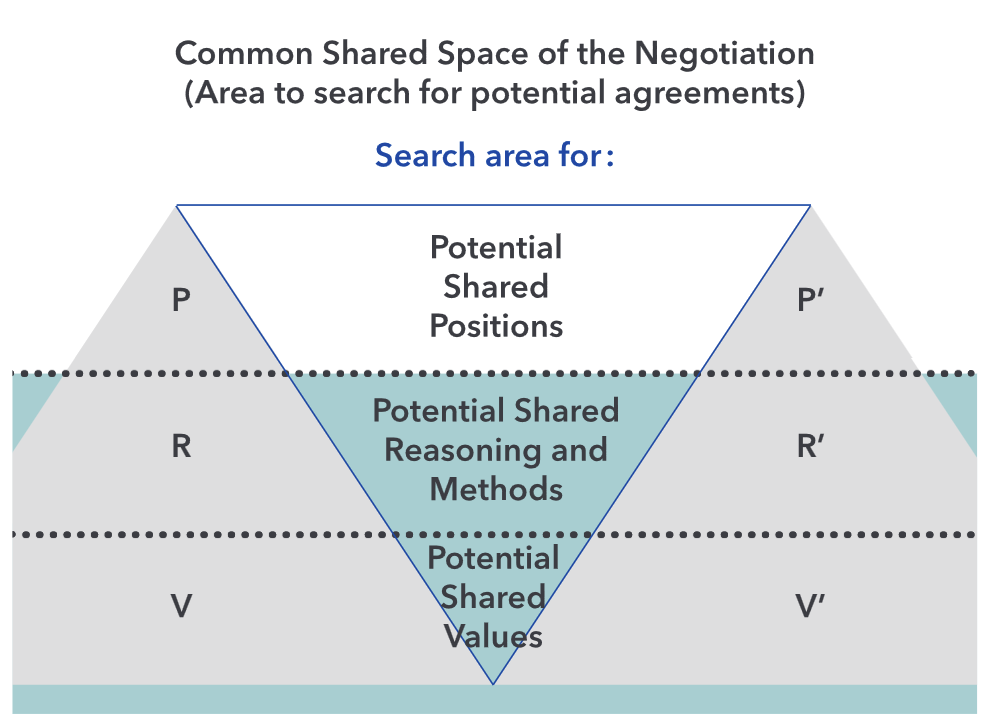
Figure 6: Defining the Common Shared Space of the Negotiation
Identifying the area of the negotiation therefore involves:
- Communication of the respective positions of the parties (P) and (P’);
- The ability to explain one’s tactical reasoning (R) and connect it to the reasoning of the counterpart (R’);
- The openness to discuss one’s underlying values and norms (V) in a language and method that may relate to the values and identity of the counterpart (V’); and,
- The recognition of the distance between the two sets of positions/methods/values in order to offer an opportunity for dialogue and improved understanding of the counterpart. In this Common Shared Space of the negotiation, which is co-owned by the negotiators, it is hoped that the parties are willing to find a compromise.
The negotiation should be presented as a process for the parties to explore ways to reconcile P, R and V with and P’, R’, and V’. For example:
Food Without Borders (FWB), an international NGO, is negotiating access to IDP camps with the Governor of a remote district of Country A. Because the rainy season has paralyzed access by road to the district, FWB is also seeking access to the local airstrip, which is under the control of the Governor. The movement of the food within the district will further require the security guarantees of the Governor and the leaders of the local militia under his control.
The object of the negotiation relates to access to IDP camps. This negotiation involves several technical issues, such as:
- Landing rights for humanitarian flights;
- Timing and itinerary of humanitarian convoys; and,
- Location and number of beneficiaries within the population of the IDP camp.
The reliance on the agreement by the parties and its implementation involve operating procedures and methods that need to be clarified at the tactical reasoning level, respectively:
- Common understanding on flight pathways and communication procedures;
- Common protocols of checkpoints and communication procedures with the militia; and,
- Common understanding on the terms of the presence and role of FWB staff in the IDP camp.
These elements of tactical reasoning are, in turn, inspired by the values and norms of the parties, hence:
- Respect for the national sovereignty and control over airspace and air operations;
- Respect for key principles in the distribution of the food to the IDPs; and,
- Respect for the counterpart’s authority over the population and security of the camp.
In other words, while the agreement with the Governor may focus on technical issues, namely, the use of the airstrip, the movement of trucks within the district, and the operations in the IDP camps, the quality and durability of the agreement in terms of implementation require a thorough engagement at the values and reasoning levels of the conversation. The frontline negotiator is well advised to take the time necessary to explore the Common Shared Space as to ground technical arrangements in a sound and shared understanding of the respective positions, reasoning, and values between the parties.
Understandably, some negotiations may already have a strong focus on diverging values (e.g., on the visibility of an emblem) or diverging tactical reasoning and methods (e.g., on the terms of the distribution of the food) that will frame further discussion on the activities of the organization at a more technical level. This focus implies that negotiators on both sides will concentrate their energy on exploring the Common Shared Space at the technical level while paying attention to the implications at the other levels. For example:
The leader of the militia objects to the use of the logo of FWB on the convoys crossing the territory under his control. He requires that all displays of the FWB logo be withdrawn from the trucks.
The humanitarian negotiator must discern if the position of the militia results essentially from:
- A disagreement about where and when the logo is being displayed (technical level);
- A divergent understanding of how the logo is being used to identify the FWB’s convoy (on the door, on flags, on the roof top, etc.) (tactical/professional reasoning level); and/or
- A divergent understanding of the meaning and implications of the logo (values level).
Issues of logos tend to focus on the “message” the logo carries, notwithstanding the intent of the organization. In this case, the leader of the militia believes that the logo is offensive toward the local culture.
Depending on the level of engagement and trust, the humanitarian negotiator will focus the search for potential agreements on the most promising areas, i.e., where the relationship has most traction, selecting, alternatively, these search areas:
- V <-> V’: The organization already has good connections with militia members as well as with religious scholars and community leaders in the region. They may recognize the non-religious and non-political character of the logo;
- R <-> R’: The organization is recognized as a professional entity. Professionals in the region may vet for the professional use of the logo so as to identify the service of the organization and ensure the security of the personnel; and
- P <-> P’: The convoys of the organization are already operating and recognized in the region and can accommodate varying degrees of visibility of its logo in the course of its operations without hindering its security. It will require a more thorough management and notification process so as to avoid any misperceptions of the humanitarian and protected nature of the convoys.
In all cases, the first step is about understanding the perspective of the counterpart and seeing how to reconcile possible divergences at the various levels of engagement. (For a more detailed discussion on the various types and levels of engagement, see 1 | Tool 4: Determining the Typology of a Humanitarian Negotiation.)
Starting with Values: Reformulating divergent beliefs into shared values
Going back to the exploration of the Common Shared Space, this segment will focus on a systematic search for shared values.
Searching for shared values is about finding overlap between the structure of beliefs of both sides and reformulating these values into a common shared vocabulary. (For a more detailed discussion on engaging on values and norms, see 1 | Tool 5: Drawing the Pathway of a Normative Negotiation.) A key aspect of the process for humanitarian negotiators is to understand that they need to move beyond the rhetoric of “humanitarian principles” to be able to explain the meaning and relevance of each of the principles in the particular context. Humanity, Impartiality, neutrality, and independence are values and norms that belong to the humanitarian community, not the parties to an armed conflict. Yet, some aspects of these norms can certainly be shared if presented in a meaningful and relevant way in the eyes of the counterparts. Hence, humanitarian principles need to be unpacked and “translated” into a palatable vocabulary for the counterpart so he/she can recognize common beliefs. For example:
The same applies to tactical reasoning and professional methods which are measurable by their capacity to mobilize a consensus among peers on HOW the organization should operate in the affected territory. There are a number of procedures and mechanisms that make a lot of sense for humanitarians but have little resonance with counterparts. These methods need to be unpacked as well in order to become tangible points of the conversation so both sides may agree on how to handle the humanitarian needs of the population. For example:
Finally, the position of the organization should be communicated clearly so that the counterpart both understands where the organization stands and perceives its willingness to engage. (For more details, see Section 1 | Fostering Legitimacy and Building Trust). Introduction of technical terms can also launch a new tangent of discussion, especially in areas of chronic emergency requiring multi-year responses, where the humanitarian lexicon can be misinterpreted or misused by counterparts. Hence, one should avoid language in a position that pre-empts a conversation or closes the door to the exploration of potential agreements, such as:
- “Under international law, we have the right to …”
- “Our organization will never accept …”
- “This position is non-negotiable.”
- “We are not willing to discuss this point.”
- “This situation is unacceptable.” Etc.
The doctrine of the organization may indeed prohibit specific arrangements proposed by the counterpart. The leadership of the organization may even call for a denunciation of the action of the counterpart. Yet, the mandate given to the humanitarian negotiator is to engage in a conversation with the counterpart, explore possibilities, and build trust, not to prohibit or denounce their action. The mandator (e.g., country director of the organization) should be the one communicating the strong prohibiting messages. Organizations must maintain the credibility of the role of frontline negotiators by sparing them from acts of denounciation or intimidation towards the counterpart. Frontline negotiators must not hesitate to request or insist on this kind of support from the negotiation team in order to preserve their place and relationship with the counterpart.
It is well understood that there will be a time to set clear “red lines” and manage expectations, which is also part of the job of frontline negotiators. Yet, the conversation on red lines can take place only if and when the level of dialogue and the engagement between the negotiators are sufficiently developed. To start a conversation by stating the red lines is an act of power subjugating the Common Shared Space to the terms of one side. It is recommended therefore that the opening position focuses on stating what the organization wants and is not construed as a negative assertion (i.e., stating what the organization rejects) as a way to open a dialogue on the views of the other side without restrictions.
Application of the Tool
As mentioned above, the Common Shared Space is a derivative of the analysis of the two icebergs and their juxtaposition. It allows for the identification of options to be explored in a first step informed by the previous identification of agreed facts and convergent norms (see 2 | Tool 2: Drawing the Island of Agreements), to be followed by the design of the scenarios and red lines which are presented in the next module (see 2 | Module D: Designing Scenarios and Bottom Lines).
The CSS is very much inspired by the Island of Agreement exercise as well as the Typology of a Humanitarian Negotiation presented in 1 | The Frontline Negotiator. The connection between these tools should be well understood.
On the Interface Between the Island of Agreement and the Common Shared Space
The Island of Agreement presented in 1 | The Frontline Negotiator and the CSS introduced in this module are important tools in the planning process of a humanitarian negotiation. While they are inspired by the same idea of sorting elements to find a conducive pathway for the negotiation, they serve different purposes:
- The Island of Agreement is a tool assisting the humanitarian negotiator in establishing a positive dialogue with the counterpart on all aspects of the situation as a basis for a trusted relationship despite potential divergences on norms and/or disagreements on facts; while …
- The Common Shared Space serves as a tool of the negotiation team identifying the convergence between the parties on specific aspects of the negotiation in terms of values, tactical reasoning, and technical positions to serve as a basis for the search for an agreement on a specific transaction between the parties.
Hence, one should be careful to keep these two tools distinct as they serve different purposes. There are objects of agreement and convergence in the Island of Agreement that are not relevant to the transaction. There are objects in the CSS model that need to be confirmed through the exploration of the space of potential transaction.
On the Interface Between the Typology of Negotiation and the Common Shared Space
Likewise, there are clear points of contact between the typology assessment presented in the tactical planning section and the CSS presented in this module. While the two are interconnected, there are, however, some differences in the use of the respective tools:
- The typology model is designed to help the humanitarian negotiator in selecting the tactical angles of his/her negotiation (political vs. professional vs. technical), as well as identifying the tactics and required human resources to bring to the table; while …
- The CSS model is designed to help the negotiation team sort out the substantive values, tactical reasoning, and position of the parties and review potential options for agreement.
These tools work together in a sequenced manner as the humanitarian negotiator and the accompanying negotiation team work through the planning process. This particular module is designed to support the deliberation between the negotiator and his/her negotiation team where options for the transactional stage are being discussed, drawing from the same taxonomy of the Naivasha Grid, taking the situation described in the previous module and building on the analysis of both icebergs:
Example
Health for All’s Surgical Team Retained in a Labor Dispute
Nine staff members of Health for All (HfA), an international health NGO, have been prohibited by tribesmen from leaving their residence in District A for almost a week following a disagreement between HfA and the guards of the local HfA hospital. This dispute arises from HfA’s plans to close the hospital due to decreasing war surgery needs in the region. The guards, who belong to an important tribe in the region, claim that the hospital should remain open and their compensation be paid as there are still considerable emergency health needs in the region. The guards, supported by tribal representatives, further argue that they put their life at risk for several years to maintain the access of patients and staff to the hospital during an especially violent conflict. Some guards even lost their life in this process and others sustained long-term disabilities. Families of the guards wounded or killed during the conflict further request long-term monetary compensation for the loss of income before HfA pulls out of District A.
For now, the hospital is barely operational, with several emergency needs left unattended. Tribal leaders are increasingly concerned about the health situation in District A and insist that the hospital remain open. Families of patients have been complaining about the lack of services in the hospital.
The tribal leaders have agreed to meet with HfA representatives to look for a practical solution. The government has refrained from intervening in what they see as a private labor dispute. The army and police have only a limited presence and control over the situation in District A and would not intervene without the support of the tribal chiefs.
In this case, the range of options includes areas of potential shared objectives at each level of the negotiation. Discussions should allow the co-ownership of the Common Shared Space and see how it can address expectations on other elements in a second step.
Step 1: Assess the potential shared values by building on the iceberg assessment mentioned in the previous modules
CONVERGENT ELEMENTS TO SERVE IN EXPLORING THE CSS
- The welfare of the community is of concern to both sides, in particular in view of the rise of communicable disease.
- Both sides also share concerns for the well-being of the families of wounded guards and those killed on duty in recent years.
- Both sides want to find a solution to this unfortunate situation as it questions their reputation in the country, affecting their leverage in other relationships.
- Both sides appreciate the importance of evidence-based decision-making, ensuring objective policies in terms of community health.
DIVERGENT ELEMENTS TO LEAVE ASIDE
- The legitimacy of tribal leaders in the eyes of the community is not a primary concern to HfA.
- The humanitarian character of the mission of HfA, in terms of proximity, neutrality, impartiality, or medical ethics, is not a particular concern for the tribal leaders.
- Continued employment of the guards is not a core mission of HfA.
Step 2: Assess the potential shared reasoning by building on the converging values mentioned above
CONVERGENT ELEMENTS TO SERVE IN EXPLORING THE CSS
- The safety and security of staff are common goals of both sides.
- It is important to de-escalate the situation and resume normal operations to mitigate reputational risks on both sides.
- Greater consultation with the community and the tribal leaders is part of the solution.
- It is important to restore the activities of the hospital and ensure the integrity of its staff and premises.
- There needs to be an assessment of the rise of communicable disease in District A.
- There needs to be an assessment of the vulnerability of families of injured guards and guards killed on duty over recent years.
- HfA as a community-based employer should consider the vulnerability of local staff as an impact of closing the hospital.
DIVERGENT AREAS TO LEAVE ASIDE
- Health care is a public service. By working in this domain, HfA may have forfeited part of its autonomy of decision-making to local leaders and community.
- Holding staff is a way of drawing attention from foreign leaders.
- HfA is a charitable organization accountable to its foreign board and donors.
- The presence and roles of local law enforcement and authorities vs. tribal leaders in this matter are problematic.
- Tribal traditions should be the governing standard of labor relations between HfA and its local staff and a measure of the liabilities of HfA toward employment of the guards and compensation of the families of injured or killed guards.
Step 3: Consider the scope of potential shared positions of the negotiation by building on the two previous steps
POTENTIAL AREAS OF AGREEMENT
- Medical needs should be addressed promptly, and staff should be allowed to return to work.
- Tribesmen should withdraw from the perimeters of the residence so as to allow staff to go back to work when necessary.
- There is no need to rush into a decision on the closure of the hospital. Further consultation should be undertaken.
- Assessment of the vulnerabilities of staff to the potential redeployment of HfA assets should be undertaken.
- HfA will seek greater support on communicable disease in the region.
POTENTIAL AREAS OF DISAGREEMENT
- HfA cannot guarantee continued employment of local staff.
- HfA cannot be seen as carrying out the responsibilities of the health authorities of District A.
- Tribal leaders cannot accept the closure of the hospital.
- Tribal leaders are not the police force in District A. They cannot guarantee the full safety and security of staff.
- Guards will not forfeit their right to full unemployment compensation.
- Families of guards will not forfeit their right for compensation.
With this analysis in mind, humanitarian negotiators are in a position to consider the design of scenarios, including the angle from which they intend to approach the counterpart, and the determination of proper bottom line and red line as presented in the next module.
Concluding Remarks and Key Lessons of This Tool
This tool provides a first opportunity to observe the new role and ethos required to enter into a negotiation process. From the role of humanitarian advocate projecting humanitarian values, norms, and methods, the humanitarian negotiator must become a legitimate interlocutor to listen to the position of the counterpart, understand its tactical reasoning, and show empathy towards its values. The humanitarian negotiator needs to identify the scope of possibilities and explore alternative ways to reconcile two competing narratives. He/she must be further able to “unpack” their own organization’s values and methods to make them palatable to the counterpart and see where it is possible to find overlaps in terms of common meanings and purposes. Some of these efforts to build a rapport may exceed the mandate and red lines of the negotiator, yet there will be a time to negotiate within more constrained spaces (see the next module). At this stage, the objective is to establish the basis of a dialogue and spend the required time understanding each other’s position.
Introduction
The purpose of this module is to examine the relationship between the humanitarian organization and its counterparts within the social and political context of the negotiation. The goal is to explore ways to mobilize support among influential stakeholders and create a conducive environment for the counterpart to move toward the demands and expectations of the humanitarian negotiator.
In the previous modules, we have reviewed the position, tactical reasoning, and values of counterparts. Interest and motive analyses assume a degree of autonomy of counterparts in determining their position at the negotiation table. Yet, we acknowledge that positions in a negotiation process are also influenced by the environment in which the parties evolve as much as by their tactical reasoning and the value judgments of others over the issues on the table. Values in particular are understood as a community concern and are open for deliberations within the social network of the counterparts. It is therefore important to integrate into the analysis the role and perspectives of other stakeholders in a negotiation process as a significant source of leverage (positive or negative) on the determination of the counterparts’ position.
To this end we use the model of the so-called “mapping exercise.” This exercise should be conducted in collaboration with the negotiation team, as it requires discussing the relative positioning of actors on a political map, best achieved through a critical and informed discussion among the members of the negotiation team, especially local national staff who benefit from connections with, and understanding of, social and political actors. Mapping is of particular importance in cases where counterparts play a key political role in their community (e.g., high-level government officials, tribal leaders, military commanders, etc.) and who may, in such cases, gain or lose considerable authority and legitimacy from humanitarian negotiation. Their legitimacy is intrinsically based on their ability to balance the interests of opposing political forces under their recognized leadership. It is therefore important to map out these converging or opposing influences in the counterparts’ decision-making process on a particular issue and situate the position and role of the humanitarian organization in this context.
The risk of conflating humanitarian negotiation and other political processes, including political mediation, is therefore real to the point that one cannot remain oblivious to the political footprint a humanitarian organization may bring to bear on the power relationships between the parties and their stakeholders.
Humanitarian Negotiation vs. Political Mediation
Humanitarian organizations negotiate for access and delivery in line with humanitarian principles, but must operate within the challenges of highly charged political environments. While both political mediators and humanitarian negotiators seek to stabilize a conflict situation and minimize risks of further escalation, the mission of political mediators is to build a political consensus to address the causes of the conflict, while the mission of humanitarian negotiators is to address the immediate humanitarian consequences of the conflict. Yet, pursuing humanitarian access is often misconstrued as a confidence-building tactic in the arena of political negotiations. To be recognized as impartial, neutral, and, especially, independent, humanitarian negotiators must avoid being involved in politically motivated processes. They must be equipped to play at times a political role, exerting pressure on counterparts to seek access to affected populations, while also globally mobilizing the necessary attention to ensure the effective delivery of assistance. In this context, one cannot disassociate the mobilization of political support for humanitarian action with the politicization of the same action in specific situations. It depends on humanitarian actors to remain in control of the political implications of their action.
There is a growing confusion between the objects of humanitarian negotiation and the objectives of political mediation. Following the development of an integrative vision of the peacekeeping, political, and humanitarian roles of the United Nations in times of conflict, there have been increasing concerns over the use of humanitarian access and delivery as confidence-building/points of pressure with parties to hostilities. To remain neutral, humanitarian organizations need to proactively assess the political map of their intervention and ensure that humanitarian action is not being instrumentalized by other stakeholders. It is imperative that humanitarian negotiators take into account the potential costs and benefits of such relationships for the counterparts and their stakeholders.[1] To support such efforts, this module proposes a straightforward mapping tool in four steps:
- The first step involves the creation of a mapping tool to situate the role and perspective of humanitarian organizations and stakeholders relative to each other on a specific humanitarian issue;
- The second step assigns the main counterpart the position in the center of the map and places all the relevant stakeholders in the respective quadrants across the map;
- The third step focuses on tactical schemes to guide the engagement of humanitarian negotiators with stakeholders to leverage their influence; and,
- The fourth and final step helps prioritize mobilization efforts toward conducive connections among stakeholders that may support a positive outcome of the negotiation.
Mapping influencers is not a scientific exercise. It relies on layers of subjective assessments of interactions between stakeholders. The point of a mapping exercise is not to forecast the outcome of a negotiation but rather to help plan the mobilization of the positive influence over a counterpart. While humanitarian negotiators mostly know stakeholders in their immediate vicinity who may leverage a positive influence, they are generally unaware of the second- and third-degree influencers from other quarters who may have an interest in the humanitarian agenda. Humanitarian negotiators are “small fishes in a very large pond.” The proposed mapping should help the negotiation team to have a larger perspective on the influences and trends that may help or hinder their efforts.
Since a mapping exercise involves processing more data than one would usually do on his/her own, it relies on the greater availability of information and analysis that is possible in a team setting. The quality of the exercise resides essentially on the ability of the negotiator to reach out to other colleagues in the team as well as external contacts to gather and analyze data on the counterpart’s network of influence. Mapping is not a one-person exercise for the negotiator alone; the extent of data accessible necessitates that it is a group effort.
[1] For a discussion on the relationship between humanitarian negotiation and political mediation, see the Report of the 2017 Annual Meeting of Frontline Humanitarian Negotiators, CCHN, Geneva, pp. 30-36, at https://frontline-negotiations.org/annual-meeting-2017/.
Application of the Tool
This segment presents a set of practical steps to map the role and interactions of stakeholders in a given negotiation process drawn from recent practice. The case presented here differs from the one in previous modules in that it provides a richer political environment based on an actual situation.
Example
Mapping the Network of Influence of the Governor of District A
The International Monitoring Network (IMN), an international NGO monitoring the treatment of detainees, is planning a negotiation regarding access to persons detained in the police stations in District A under the authority of its Governor, a prominent political leader in the region. This negotiation of access follows allegations of ill-treatment of detainees in the immediate period after their arrest. While the Governor is known to maintain a strong grip on the justice and detention system in District A, there are numerous stakeholders at play in the context, including:
- Several humanitarian and advocacy actors, both international and local, who have been voicing their concerns on the issue of ill-treatment, including the ICRC, the Office of the United Nations High Commissioner for Human Rights, MSF, Human Rights Watch, Amnesty International, local journalists, a women’s association called “Mothers of the Missing,” as well as local networks of medical doctors, etc.
- Several international actors who have been supportive of the strong hand of the Governor in maintaining security and law and order. District A is a strategic geographic area for several countries. The International Military Alliance as well as the Special Forces of the neighboring Country A have deployed troops in the District to counter terrorist actions. Foreign intelligence services are training local investigators and diplomats of Country A and Country B are maintaining strong political support for the Governor.
- Many local actors involved who have been keen to maintain a strict legal and moral order and prevent the worsening of the security situation which could be used as a justification by foreign powers to justify a military intervention. These actors include tribal leaders, religious leaders, local militias, prison staff, police commander, etc.
- Private actors such as family members, friends, political observers, and others who can play a critical role in the perception of the counterparts.
All these actors exert a degree of influence on the policies and decisions of the Governor in terms of access and transparency regarding the treatment of detainees in the police stations of District A. The negotiators from IMN will need to draw a map of the network of influence of these actors.
In this case, the range of options includes areas of potential shared objectives at each level of the negotiation. Discussions should allow the co-ownership of the Common Shared Space and see how it can address expectations on other elements in a second step.
Step 1: Define the axes of the two-dimensional stakeholder map
A stakeholder mapping tool aims to assess the connections and influences among people and entities through their assigned locations on a map. It provides a set of values to the actors placed on the respective axes of the map based on their position on each of the scales. The first step is thus to define the meaning of the axes of the map, which should reflect the most apt criteria to position the stakeholders in terms of their perspective on the issue of the negotiation and their characteristics compared to the main counterpart to the negotiation.
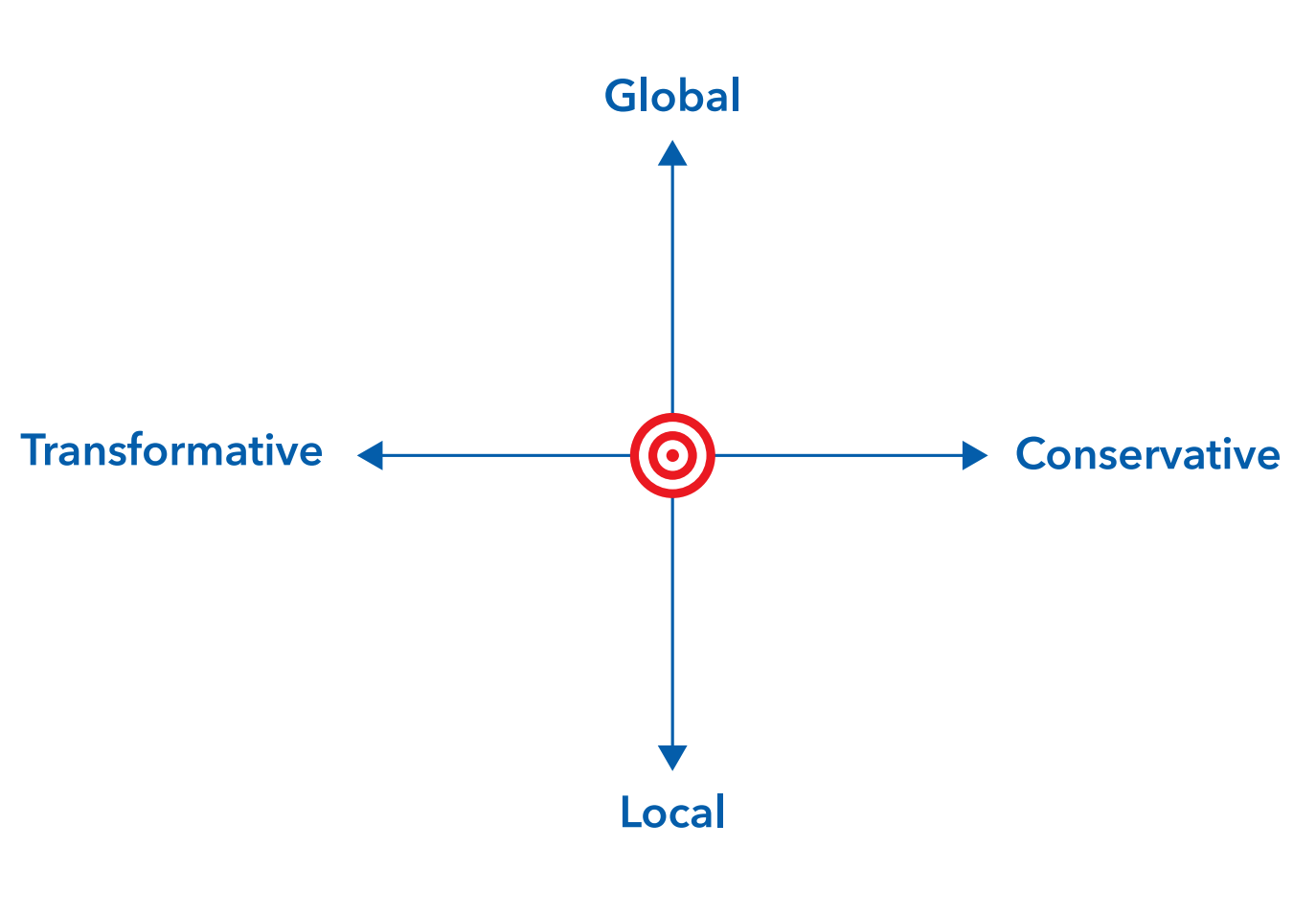
HORIZONTAL AXIS
Distributing stakeholders based on their views on the issue of the negotiation from a transformative to conservative perspective
The horizontal axis allows the differentiation of perspectives among stakeholders regarding their individual perspective on the issue at the negotiation table: in the case above, the access to police stations for the purpose of monitoring the treatment of detainees.
The horizontal axis follows a traditional political scale model of “left” to “right” positioning, the left part being composed of people and organizations that aim to reform or transform the current policy, the right part being composed of people and organizations that want to maintain the current policy and ensure the continuation of the current system. The farther away from the center in either direction, the more radical the perspective of the actors compared to the other stakeholders.
VERTICAL AXIS
Distributing stakeholders based on their identity from global to local actors
The vertical axis provides comparative values of the stakeholders’ influence based on their identity relative to the counterpart as a point of leverage around the negotiation table. Although stakeholders may converge or diverge on the particular issue at the negotiation (see the scale of the horizontal axis), they may share some characteristics in the eyes of the counterpart according to how they are grouped in terms of global vs. local constituencies. It is important to note that these characteristics are linked to the perception of the counterpart, in this case the Governor, not the ambition or self-perception of the actors. Hence, as much as an international NGO wants to be connected to the local population, it may well be perceived as a global actor by the Governor, situating it in the top part of the vertical axis. Likewise, as much as a local actor may wish to be perceived as connected to a global movement (e.g., promoting human rights or being part of the Red Cross/Red Crescent Movement), it may remain a local actor in terms of influence in the eyes of the Governor, since it is composed mostly of local professionals or volunteers and connected to local constituencies. The same applies to all the actors on the map that have any degree of influence on the issue, according to how they are distributed in the four quadrants of the map. One should note that other characteristics, such as ideological, religious, or personal, could also be used to array the actors on the vertical axis. The point is to see what identity politics come into play in the particular context and how humanitarian agencies are perceived along these lines.
Step 2: Identify your target and assign positions of influence to all the stakeholders
At the center of the map is the main counterpart, the Governor of District A, who has key/central authority regarding the issue of negotiation. The negotiator must also place his/her own organization on the map to reflect the role that it plays in the decision-making process of the Governor and to be visible to him/her.
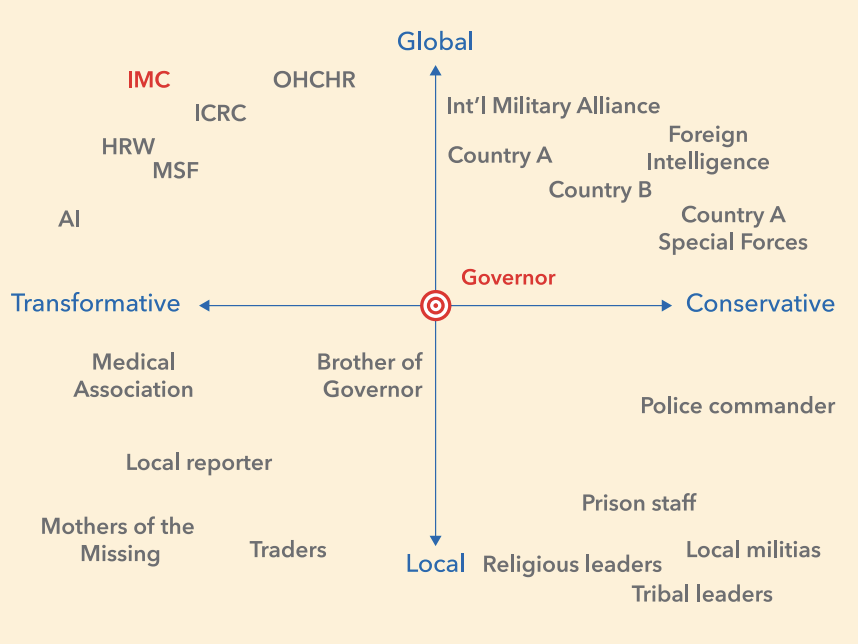
As may be noted, the stakeholders are distributed in the four quadrants based on their assumed position on the access of international monitors to police stations in District A in relation to the Governor and their identity in terms of perception of the Governor. While some actors are in favor of the demands of IMN, others are not. These actors are further distributed based on their local vs. global characteristics, allocated in relation to each other in their respective quadrants corresponding to their positions and characteristics.
The center of the map is entirely relative to the focus of the negotiation. In other words, each of the stakeholders on the map is at the center of its own network map. The subjective perception of the characteristics of the other stakeholders is very much linked to their respective position on the map. What is perceived as transformative or conservative by one actor may be singularly different from the perspective of another actor. (Special Forces of Country A may well perceive the International Military Alliance as a transformative actor, while the ICRC will see it as a conservative actor. Likewise, Amnesty International may see the Medical Association as a local actor, while Mothers of the Missing will see it as a more global actor.) Perception very much depends on the individual position on the map. This relative perspective becomes significant once IMN starts relating with these stakeholders to understand the entry points of the relationship from their own perspectives.
While each of the quadrants constitutes in effect a cluster of interests in the eyes of the Governor, the actors may well be in a competition with each other, to the great benefit of the Governor. The main objective of a powerful political actor in the center of a map is to maintain his/her position at the point of equilibrium among all the competing actors.
Hence, the Governor may have a tactical interest or motive to move “left” on the issue of access to police stations, as well as “north” on the role of global influencers, by granting access to IMN. Such position will:
- Come as a direct political benefit to the organization in the upper-left quadrant (Global Transformative), showing the success of the global transformative agenda on human rights;
- Come at the direct political cost of those in the lower-right quadrant (Local Conservative), who lose in terms of both influence and options;
- Be seen as a risky move by those located in the lower-left quadrant (Local Transformative) while it goes in the right direction in terms of options—yet, the position will underline the loss of local influence over the issue of access to police stations by granting this right to a foreign organization;
- Be recognized by those located in the upper-right quadrant (Global Conservative) as the Governor becoming more amenable to global influencers but appearing misguided regarding the policy of access to police stations.
For his part, the Governor will attempt to remain within the “acceptable” limits (the red lines) of all the competing actors to maintain the legitimacy of both his/her authority over the issue and point of equilibrium. In other words, as the negotiation team designs the scenarios of the upcoming negotiation, they should be cognizant of the limitations imposed by the red lines of other influential actors on their counterpart. In this case, the local militia may have stringent red lines imposed upon the Governor regarding the treatment of enemy combatants in prison, limiting the Governor’s ability to make compromises with IMN. Similarly, humanitarian actors may impose tough lines with respect to human rights and IHL that may hinder the capacity of the Governor to concur with most of the demands of the militia.
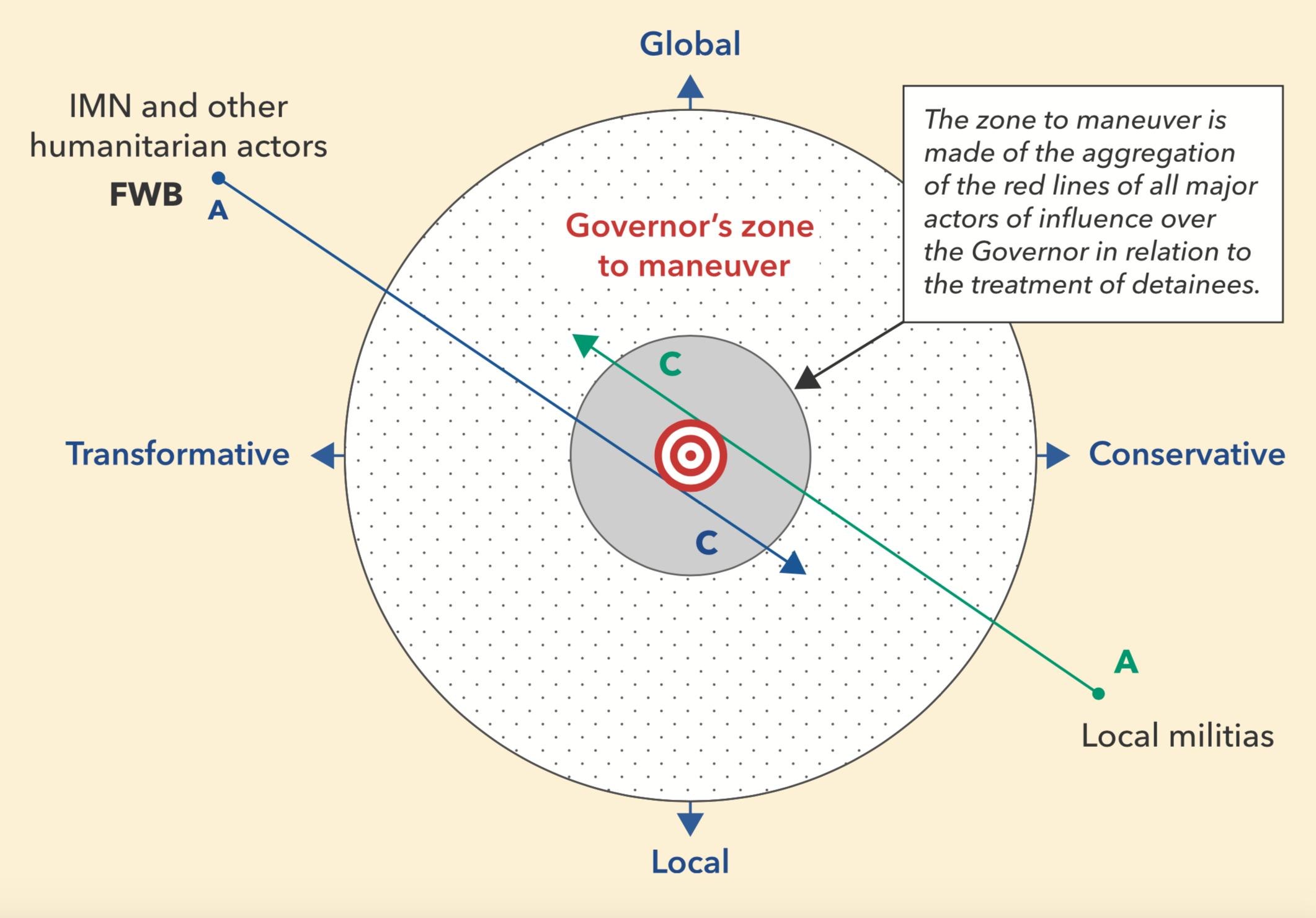
Overall, each move of the Governor toward IMN negotiators will be interpreted in political terms by all the other stakeholders and will impact their individual political relationships with the Governor. A major success of the humanitarian actors may translate into major problems for all the other stakeholders, restricting the Governor’s ability to agree to sensible demands at the risk of prompting political and security risks for him/her and some of the stakeholders.
Step 3: Engage with the stakeholders in the four quadrants of the map in order to prepare the negotiation and mobilize positive influences
Humanitarian demands may have serious political and security ramifications. It is critical that humanitarian negotiators engage with all the stakeholders on such concerns to determine their own agenda and maximize or minimize the impact of the negotiation outcome on those stakeholders. Such efforts should be made visible to the Governor in order to help convince him/her that the cost of moving in the appropriate direction envisaged in the negotiation process (always within the limits set by the aggregation of the red lines of all major actors) is affordable.
There are four distinct tactics to engage with other stakeholders, depending on their locations on the map of the Governor. Assuming that the humanitarian negotiator is positioned in the upper-left quadrant, the IMN tactics will be distributed as follows:
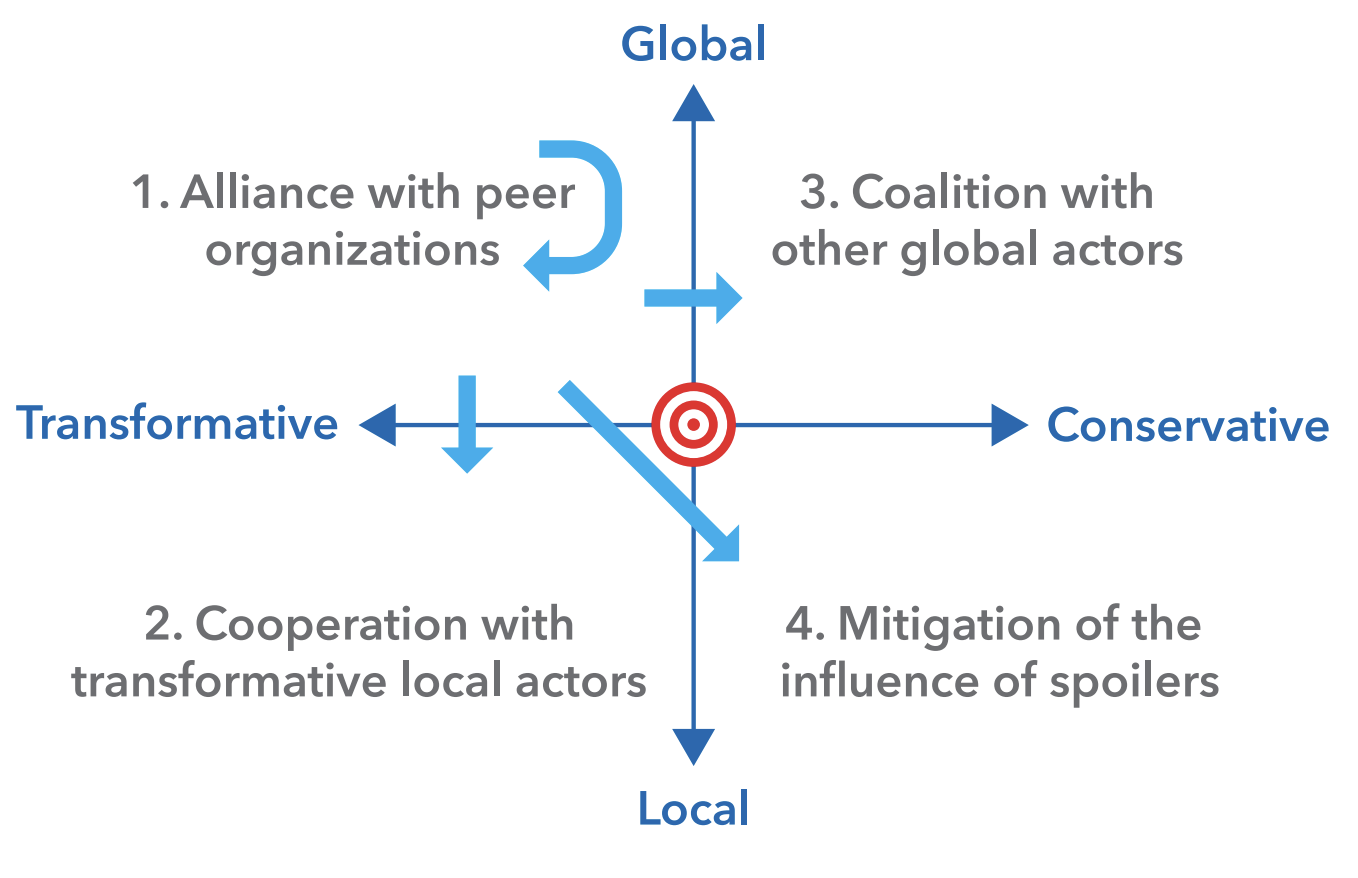
Figure 8: IMN tactical scheme to exert influence over the Governor’s position

Overall, each move of the Governor toward IMN negotiators will be interpreted in political terms by all the other stakeholders and will impact their individual political relationships with the Governor. A major success of the humanitarian actors may translate into major problems for all the other stakeholders, restricting the Governor’s ability to agree to sensible demands at the risk of prompting political and security risks for him/her and some of the stakeholders.
1. ALLIANCE
Alliance with those in the same quadrant of the negotiator’s agency who have a lot to gain from the negotiation process, located in the Global/Transformative quadrant.
Actions may include:
- Comparing notes on the allegations of ill-treatment;
- Identifying common norms of behavior for treatment of detainees in District A;
- Coordinating the targeting and timing of humanitarian interventions;
- Seeking a common plan for a review of the conditions of detention.
The objective of these interactions with IMN is to maximize the coordination among stakeholders to achieve the goal in the quadrant in full view of the Governor. Coordinating similar actors is a difficult task as it often questions the individual identity of the respective actors. One point to underscore, in view of the similarities of the messages, is that there is much more to gain by working together than by competing.
2. COOPERATION
Cooperation, in the perception of the Governor, with those on the adjacent vertical quadrant across the Global/Local divide who may gain in terms of visits to the police station but also lose influence during the negotiation process, located in the Local/Transformative quadrant.
Actions may include:
- Providing support to local organizations in their interventions (as compared to co-opting local actors in global interventions);
- Providing technical assistance and training;
- Providing funding support to develop the capacity of local organizations.
The objective of these interactions with IMN is to support local actors in a visible way so as to demonstrate to these actors and the Governor that IMN understands the exposure of the Governor to an increasing global influence with consequences that IMN attempts to mitigate.
3. COALITION
Coalition, in the perception of the Governor, with those on the adjacent horizontal quadrant across the Transformative/Conservative divide who may gain influence over the Governor but lose control over the presence of foreign observers in the negotiation process, located in the Global/Transformative quadrant.
Actions may include:
- Participating in cultural and official events sponsored by the conservative/global stakeholders;
- Establishing a dialogue on parallel issues;
- Enhancing the collaboration on issues of interest to the conservative/global stakeholders.
The objective of these interactions with IMN is not to agree on the issue of the negotiation (e.g., options for visits to police stations), but rather to develop relationships across the option divide, i.e., on other issues so as to create bonding with other global actors in full view of the Governor. The point is to demonstrate to the conservative global stakeholders that IMN is aware of the importance of global influence, and to the Governor that IMN is eager to manage his exposure for a move toward the transformative scale.
4. MITIGATION
Mitigation with those on the opposite quadrant across both divides, often referred to as the “spoilers,” who have nothing to gain from IMN’s access to police stations and carry a significant influence on the Governor, located in the Local/Conservative quadrant.
Actions may include:
- Establishing dialogue with conservative and local actors for the purpose of understanding their concerns;
- Providing support to technical projects (e.g., training, workshops) on issues of interest (e.g., forensic) in full view of the Governor;
- Personalizing relationships away from institutional constraints so as to rebuild a more amenable image;
- Developing a trustful relationship on the overarching humanitarian character of the mission of IMN in line with local values.
The objective of the interactions with IMN and conservative local actors is to mitigate the risks that spoilers may present by assessing their red lines in terms of negotiation with the Governor regarding IMN’s access to police stations and seeing the extent to which IMN representatives could alleviate the concerns of these groups.
Please note that this tactical map is made for IMN as a transformative global actor. The same scheme applies to all the other actors in their respective quadrants through inverting the tactical options. Therefore, a local transformative actor will seek to build alliances within its quadrant, cooperate with transformative global actors, build coalition with conservative local actors, and mitigate the influence of conservative global actors.
Concluding Remarks and Key Lessons of This Tool
This tool focuses on the environment of the counterparts as sources of influence on their position at the negotiation table. Building on the previous modules, it recognizes the role of humanitarian negotiators as networkers in given social and political contexts. The module provides simple mapping tools to locate and assign roles to stakeholders of the counterparts’ policies that affect populations. It concludes by recognizing that humanitarian negotiators should not expect full compliance with the rules of IHL or count on the success of their negotiation. Humanitarian negotiation is akin to a political process for many counterparts. Counterparts have only a limited space in which to move within the acceptable margins of all the stakeholders. The political cost of moving toward the demands of humanitarian organizations will increase as the counterparts make compromises. Network mapping remains a critical tool to initiate a conversation with members of the negotiation team on networks of influence, with the discussion informed by the data and knowledge collected by both the team and, especially, national staff, who usually have a greater knowledge of the political ramifications in a given context.
Introduction
The design of scenarios occurs when the preparatory steps of the negotiation planning process have been for the most part completed: the context has been analyzed; the interests and motives of the counterpart have been surveyed; and relationships with the counterpart and major stakeholders have been established. The relational stage of the negotiation has allowed for the elaboration of a series of tactical steps to engage with the counterpart in a dialogue. Yet, before engaging in the final stage of the negotiation, i.e., the search for an agreeable solution, the team should consider the limits of the negotiation set in the terms of the mandate based on the legal, institutional, professional, and moral frameworks of the organization.
Though working within a limited exploratory framework, the negotiator is tasked with finding a suitable agreement with the counterpart that will be compatible with the rules and policies of the organization. Setting up the red lines of the mandate frames the scope of options to be considered in a possible agreement. This module proposes some tools to plan the conversation on the description of red lines and bottom lines with the counterpart.
Tool 13: Identifying the Shared Benefit of the Negotiation
A critical aspect of the design of scenarios is to contribute to a new mindset within and across the parties about the added value of an agreement for both sides. Arguably, any agreement could be characterized as a bundle of compromises. Unless the added value of an agreement can be measured on features other than mere gains and losses for the respective parties, it remains vulnerable to detractors who may condemn any sort of agreement as a “bad deal.”
To build a sense of ownership into the agreement and its implementation, one needs to demonstrate the creation of a shared benefit as the main outcome of the negotiation. For example, in the humanitarian sector, this added value can come from having an impact on the situation and population or demonstrating leadership in the domain. On the side of the counterpart, it should provide for a source of benefit as well, which would most likely be related to security, economic, or political interests, such as greater control over the relief operation, or legitimacy in the eyes of their own hierarchy or constituency. Multiple benefits can co-exist in the same agreement. The humanitarian negotiator and his/her team should therefore undertake an assessment of the interests and values of the counterparts as well as their constituencies to find the right point of connection for the shared benefit.
Defining “Red Lines” vs. “Bottom Lines”
Red lines: For the purpose of this Manual, red lines are defined as the outer limits of the possible areas of an agreement. Red lines set the space in which parties to the negotiation can maximize their shared benefit as a result of the negotiation. They are generally specified in the mandate given to the negotiator. The mandate is informed by the applicable laws as well as institutional policies of the organization. Red lines cannot be crossed; the cost of breaching one or more of these normative frameworks would lead to significant consequences regarding the validity and legality of the agreement between the parties and may have major implications as to the legitimacy of the negotiator and his/her own organization. A breach may also involve legal liabilities for the negotiator, e.g., regarding issues that fall under counter-terrorism legislation. Under the rules of the mandate, the negotiator is, in principle, not allowed to set or revise the red lines of the negotiation mandate.
Bottom lines: Bottom lines are understood as a tactical tool at the disposal of the negotiator to set limits to the conversation between the parties when options under consideration show definite rising risks and diminishing benefits of the negotiation. Bottom lines are under the control of the negotiator as a means to suspend or postpone considerations of additional options below a certain threshold of possibilities. Before considering these options, the negotiator may consult again with his/her hierarchy or stakeholders in the process. The results of the consultation may impact the location of the bottom line of the negotiation and its scenarios.
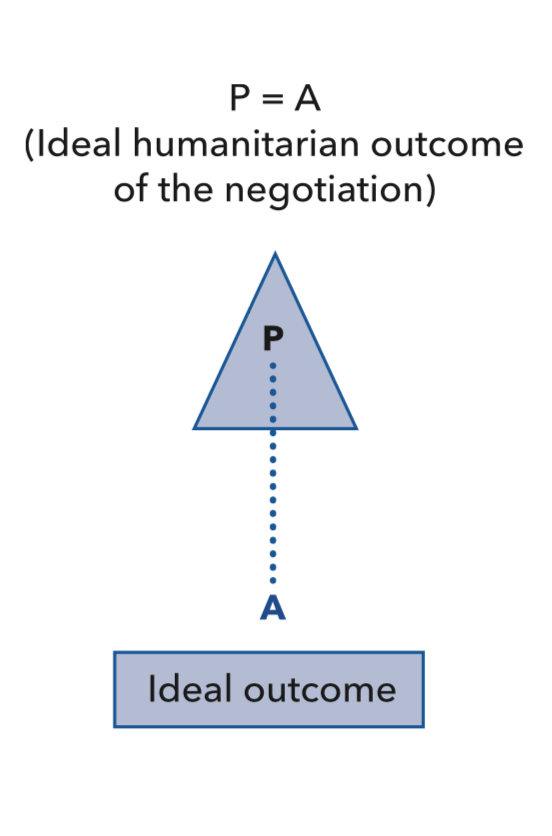
For the humanitarian organization, the starting position of the negotiation sits at the top of the organization’s iceberg, identified as the ideal outcome of the negotiation, where the benefit of the agreement for the humanitarian organization is maximized with little to no compromise required. However, as attractive as this position may look in absolute terms, it remains unrealistic since it does not take into consideration the interests and motives of the counterpart and does not involve any shared benefit.
For the humanitarian organization, the starting position of the negotiation sits at the top of the organization’s iceberg, identified as the ideal outcome of the negotiation, where the benefit of the agreement for the humanitarian organization is maximized with little to no compromise required. However, as attractive as this position may look in absolute terms, it remains unrealistic since it does not take into consideration the interests and motives of the counterpart and does not involve any shared benefit.
As compromises to the “A” position are being considered (i.e., gradually moving away from the ideal outcome for the humanitarian organization):
- The potential benefit of the agreement for the humanitarian organization decreases up to a given point where there is no benefit to agree to a particular position.
- The same applies to the counterpart considering its compromises to A’ starting point.
- Conversely, the possibility of arriving at a viable agreement increases with the flexibility of coming to an agreement within the shared benefit window, enhancing a sense of joint ownership in the agreement.
In reality, what is considered to be shared benefit is relative to the number of issues being negotiated at the same time. Most negotiations address a bundle of issues and require smoothing the angles and adding scale to the shared benefits of a joint approach.
However, although compromises generate shared benefits for the parties to the negotiation at first, they also come with diminishing returns later on. The maximum shared benefit resides at the point where both parties have maximized their mutual interests in the issues on the negotiation table. Beyond that point, the discussion again becomes a zero-sum game—the greater the gain on one side, the lesser the benefit will be on the other, bringing down the shared benefit of the parties and sooner or later reaching the limit of the benefit of the most compromising party.
Taking as an example Food Without Borders (FWB) negotiating access to an IDP camp in order to address the food insecurity of the affected population:
- A = Ideal outcome of the negotiation: Food Without Borders wishes full access to the affected IDP population in the camp with no presence or control by the military during the food distribution.
This ideal position represents the best way to ensure the strict humanitarian character of FWB’s food assistance to the IDPs, recognizing the role of FWB as a neutral and impartial entity.
- Potential compromise “1”: FWB wishes full access to the IDP camp with a limited presence of the military in the camp during the distribution process.
This first degree of compromise appears to be a quick gain for FWB with the most benefit on the humanitarian organization side and limited cost on the humanitarian character of the assistance. The presence of the military is tolerated as long as they are not visible during the distribution process.
- Potential compromise “2”: FWB wishes full access to the IDP camp with the presence of the military actively monitoring the distribution process led by FWB.
This second degree of compromise is a somewhat more precarious position for FWB, affecting the perception of independence and neutrality of the FWB distribution process, yet not infringing on FWB’s capacity to distribute food to people in need. It also provides a benefit to the camp commander by ensuring an acceptable and visible level of control over the food distribution operation.
- Potential compromise “3”: Due to insecurity, FWB is ready to accept limited access to the IDP camp with a military escort. Providing a list of the beneficiaries to camp authorities is further required from FWB prior to the distribution process.
This third degree of compromise is much harder for FWB to agree with as it represents a significant compromise to the neutrality and independence of the organization, although not directly pre-empting the capacity of FWB to distribute food to all IDPs in need. However, FWB may not have the means of verifying that the assistance has reached those most in need. The benefit of the negotiation starts to decrease to a point where it may become unpalatable for FWB.
In other words, compromises come with a cost represented by the risks the compromises pose to the integrity of the humanitarian organization and its operations. As the humanitarian negotiator contemplates compromises, s/he should evaluate the rising risks for the organization.
The sources of these risks involve issues such as (but not limited to):
- Respect of humanitarian principles
- Security risks for staff
- Protection of the affected population
- Other legal norms (e.g., counter-terrorism legislation)
- Efficiency of distribution and other professional standards
- Reputational risks for the organization.
These risk sources are often analyzed as part of the organization’s mandate and/or institutional policies that provide the necessary framework for the negotiation (see 3 | Module B: Considering Institutional Policies and Red Lines). They are also an important topic of discussion with the negotiator’s support team.
Although all these options (1, 2, 3) may be palatable under the mandate of the humanitarian negotiator, there is a definite point where the negotiator may wonder if the benefit of the additional compromise is worth the additional risk. This natural bottom line of the negotiation (point B) is the point of equilibrium that represents a line set by the negotiator prompting a change in the dynamic of a conversation in which the negotiator may find himself/herself pressured into an increasingly compromising and risky posture while the shared benefits and ownership of the negotiation keep shrinking. A negotiation scenario on access to a conflict or insecure area is usually centered on absorbing more risks in terms of integrity of the organization and its personnel while observing a varying return in terms of humanitarian outcomes. The bottom line is situated when and where the diminishing return crosses the rising risk, calling for a pause in the dialogue with the counterpart to allow some reflection with the team and reconsideration of further compromises with the mandator.
As mentioned above, identifying a bottom line is a matter of evaluating the benefit/risk ratio of a particular negotiation in a specific context. Red lines are different: they are the product of institutional policies across contexts and are established at the outset of the negotiation process as fixed limits to the mandate of the negotiators. They are based on a doctrinal understanding of the tolerance of an organization to a set of compromises and associated risks. If they can be slightly modified in a dialogue with the mandator, they are unlikely to be moved significantly, even with the benefit of a high humanitarian return in a specific negotiation.
It may happen that a red line is set at a higher level than the point of equilibrium between shared benefit and rising risks as a matter of policy for the organization. For example, considering that military escorts are prohibited as a matter of institutional policy at the ICRC, the fact that many more lives could be saved through access with a military escort is unlikely to have much impact on the red line of the organization in a particular negotiation. Such a decision preempts a discussion between the parties on the risk/benefit of military escorts as this option has been discarded from the outset in the mandate. Further, there is also no point in having a bottom line on this issue.
However, a military escort may be seen differently by a local NGO implementing a government program than by the ICRC. In such case, a local NGO may be better suited to create a shared benefit with the counterpart than other international organizations that are subject to more restrictive institutional policies. The counterpart could try to pressure the more restrictive organizations into greater compromises on the basis of the tolerance to risks of the other organization. Yet, the negotiator with the more restrictive organization should not buckle to the pressure. The mandator and the hierarchy of the organization have already opted for the prominence of the reputation and integrity of the organization as a matter of policy over the long run, even at the cost to the affected population over the short run. The negotiator is not responsible for that policy decision and does not have permission to engage on it.
Assessing one’s own red line and bottom line
Referencing the bottom line, the humanitarian negotiator can, without breaking the relationship, inform the counterpart that they will need to pause the conversation, with the negotiator pulling out of the open dialogue to measure the actual risk/benefit with the negotiation team and, if needed, with the mandator. Once the new instructions are received, the dialogue may then continue to explore options up to a clear set of red lines (between B and C). Citing the bottom line communicates to the counterpart that the interests of the humanitarian organization in a shared agreement are diminishing quickly and the mandatee is getting close to the limit of his/her mandate to negotiate; this is the point below which the humanitarian negotiator is no longer able to entertain a discussion on options. It is up to the humanitarian negotiator to determine if, when, and how to communicate the bottom line to the counterparts.
Tool 14: Evaluating Cost-Benefit of Options
The purpose of designing a scenario is to frame a conversation between the humanitarian negotiator and his/her support team to deliberate on the various elements of the negotiation tactics.
As compared to red lines, which are derived from the mandate of the negotiator, bottom lines are tactical tools at the disposal of the negotiation team to increase the chances of building a trustful relationship with the counterpart and maximizing the shared benefit of the negotiation, such that the negotiators on both sides can arrive at an agreement and implementation without having to refer back to an external authority. For example:
Example
FWB is Required to Pay Local Laborers in Kind in the Distribution of Aid to the IDP Camp
Food Without Borders (FWB) is planning to distribute food rations to an IDP camp in District A.
The authorities of the camp require that FWB hire local security guards to assist in the distribution of the food rations. These local guards are members of the armed militia that prompted the displacement of the population over recent months. The authorities argue that the work required from the guards goes beyond their security functions. Compensation is therefore due to these guards as for any other day laborers. The authorities of the camp will not allow anyone else to work for FWB.
The local security guards want food rations as compensation for their work. Payment in cash is hardly feasible in the region and food rations are becoming the only acceptable currency.
As a humanitarian organization, FWB is committed to providing humanitarian assistance to people most in need based on its humanitarian principles.
In line with the principles of neutrality and impartiality of FWB:
- Point A: The ideal outcome for FWB is that all food rations are distributed only to the affected IDP population based on their nutritional needs and that FWB can hire and pay in cash the day laborers of their choice to assist in its work in the IDP camp.
- Point B: The bottom line of the FWB negotiator is that food rations should be limited to IDPs but are not necessarily dependent on their individual nutritional needs. While not all IDPs suffer from the same level of malnutrition, general food distribution, with its possible conversion into cash by IDPs with limited or fewer needs, is seen as an acceptable risk. Regarding the hiring of local guards, FWB could consider including their family members in need as part of the food distribution process, even though they are not recognized as formal IDPs. Direct distribution to the local guards, however, is not permitted in view of their visible connection with the armed militia. The compromises outlined here, also show diminishing benefit for FWB as the connection between food assistance and the needs of the IDPs is getting lost.
- Point C: The red line according to the mandate given to the negotiator by FWB hierarchy is that FWB can only distribute food rations to the IDP population and other people in need. It cannot use the food rations as a means of payment of laborers. It further cannot provide any direct assistance to armed personnel. This position is consistent with the institutional policy of the organization prohibiting the use of food rations as a cash substitute for commercial transactions or compensation for labor. The concern of FWB across its operations is that food rations used as currency could appear to be a diversion of food aid and then be sold to the IDPs, creating a commercial interest in preventing the food from reaching those most in need, and making a profit for the sellers out of the IDPs’ malnutrition.
It is important to note that any compromise in the area between B and C, below the strict targeting of IDPs, will require further instruction from the mandator. FWB is rightly concerned about the reputational risks attached to food diversion and the fact that security guards may belong to a local militia active in the conflict, raising new concerns regarding the principle of neutrality. Discussing food distribution to family members of the security guards is below the bottom line (point B) but could be above the red line (point C) if the families of the guards are food insecure. In such case, the negotiator should refer to the mandator the request for food distribution to the guards, while explaining to the counterpart the limitations on FWB regarding the terms of the food distribution.
The reading of the situation in the case above could look like:
- The ideal outcome of the Camp Authorities (point A’) is to ensure the highest level of control over FWB’s presence and operation in the camp, requiring FWB to hand over distribution of the food to the camp guards and let them manage the process for a payment in food rations.
- The bottom line of the authorities of the camp (point B’) could be to allow FWB to manage the food distribution in the camp but only through the hiring of local security guards in the camp and providing their compensation in food rations. Any compromise below this point will require a consultation with the camp commander and the leader of the militia providing the security guards.
- The red line of the authorities of the camp (point C’) could appear at the point where they entirely lose control over the food distribution in the camp and become unable to share some benefit with the local security guards and their families as a side benefit for their work and allegiance.
Discussion of the modalities of payment to the guards proposed by FWB, e.g., to distribute assistance to the members of the local guards’ families in need and not to the guards directly, is probably above the red line of the camp authorities and the bottom line of their negotiator. The negotiator may probably agree on a scheme of distribution of food to the families of the guards, in exchange for which FWB will have full access to the camp with limited military presence.
In view of this assessment, the negotiator of FWB is in a position to draw the most likely scenarios of the specific negotiation:
Once the two lines of arguments are drawn, one can set the possible scenarios of the discussion.
Common Shared Space “D” + “E” + “F”: This is the shared space of potential agreements between the two sets of red lines, composed of:
- Area “D”: Area of potential agreement favoring mostly FWB but requiring the Camp Commander to refer back to his/her mandator;
- Area “E”: Area of potential agreement favoring both sides within the limits of the respective bottom lines; and,
- Area “F”: Area of potential agreement favoring mostly the Camp Commander but requiring the FWB negotiator to refer back to FWB hierarchy.
Within Area “D”, FWB may be pushing the conversation toward a more principled approach at the cost of the relationship with the counterpart as well as being likely to take more time. FWB negotiators could insist that:
- the security guards may take part in the distribution, but only as observers—they cannot handle the food rations;
- the families of the guards can receive food rations, but they will need to register with FWB, the same as everyone else.
This scenario implies that the counterpart is likely to require new instructions to agree and may raise the possibility of the politicization of the negotiation by the Camp Commander.
Within Area “E”, the two sides may come to an agreement within the mandate (the space between the two respective bottom lines, B and B’, as a shared space of open dialogue). In this case, the security guards can take part in the distribution and their families can receive additional rations to the extent they are food insecure.
Within Area “F”, the camp authorities may require, as a pragmatic step in the operation, that the food rations to be distributed to the families of the guards be handed over directly to the guards as a form of payment. This scenario implies that the FWB negotiator will have to refer back to the FWB hierarchy as it involves handing over food rations in a visible way to security guards who are also members of the local militia.
Other scenarios
The actual negotiation can be hard to predict. The scenarios mentioned above are based on the information collected so far. What seems clear is that scenarios that would not involve the security guards or full control of the distribution of aid by security guards are off the table. So, there is no point in pondering these possibilities for too long if FWB or the camp authorities are unwilling to move from their principled positions, affording little hope of finding an agreement.
On the Role of Stakeholders
A final point in drawing scenarios should be made regarding the role and influence of stakeholders. The position of the counterpart in a negotiation is as much the product of its relationships with influential stakeholders as of its interests and motives. Taking that into account, one should acknowledge that the actual scenarios of a negotiation are often a derivative of the objectives and tactics of other major stakeholders. In our case, the camp authorities may not be entirely free to set their red lines in view of the potential influence of armed militias supplying the local guards. The same applies to FWB, which remains very much under the influence of its donors and other humanitarian agencies. As one has analyzed the mapping of influence of the counterpart, one should also note that red lines of other actors, in particular, “spoilers,” may impact heavily on the openness of the counterpart to compromises. (For a more detailed analysis, see 2 | Module C: Network Mapping.)
Application of the Tool
This segment presents a set of practical steps to design a scenario for the negotiation process based on an analysis of the bottom line and red line of a negotiation. It examines the case brought up in the previous modules regarding the retention of staff to exemplify the steps to be followed in this process. The case is presented here as a point of reference. As a result of the analysis in the previous modules which identified the priorities and specific objectives of the parties, the negotiator should be in a position to design the scenarios of the transaction, drawing the necessary bottom lines and recognizing the reciprocal red lines.
Example
Health for All’s Surgical Team Retained in a Labor Dispute
Nine staff members of Health for All (HfA), an international health NGO, have been prohibited by tribesmen from leaving their residence in District A for almost a week following a disagreement between HfA and the guards of the local HfA hospital. This dispute arises from HfA‘s plans to close the hospital due to decreasing war surgery needs in the region. The guards, who belong to an important tribe in the region, claim that the hospital should remain open and their compensation be paid as there are still considerable emergency health needs in the region. The guards, supported by tribal representatives, further argue that they put their life at risk for several years to maintain the access of patients and staff to the hospital during an especially violent conflict. Some guards even lost their life in this process and others sustained long-term disabilities. Families of the guards wounded or killed during the conflict further request long-term monetary compensation for the loss of income before HfA pulls out of District A.
For now, the hospital is barely operational, with several emergency needs left unattended. Tribal leaders are increasingly concerned about the health situation in District A and insist that the hospital remain open. Families of patients have been complaining about the lack of services in the hospital.
The tribal leaders have agreed to meet with HfA representatives to look for a practical solution. The government has refrained from intervening in what they see as a private labor dispute. The army and police have only a limited presence and control over the situation in District A and would not intervene without the support of the tribal chiefs.
Step 1: Lay down the best possible outcomes on both sides
The negotiation team should first lay down the starting positions of the negotiation on both sides showing the ideal outcome of the process according to their individual perspectives. These positions were identified in the previous modules on the icebergs.
IDEAL OUTCOME OF HFA (A)
- HfA insists on the immediate release and evacuation of all HfA staff from District A.
- Tribal leaders must guarantee the safety and well-being of HfA staff in the meantime.
- HfA scales down its health activities in the region and hands over the hospital to a third party, including obligations toward the guards and their families.
- Meanwhile, HfA engages in consultation to rebuild trust with the community.
IDEAL OUTCOME OF TRIBAL LEADERS (A’)
- Tribal leaders insist on keeping the hospital fully operational under HfA or equivalent.
- HfA should maintain the employment of security guards from the tribe.
- Families of wounded and deceased guards should be properly compensated.
- Retained staff will be released only when guarantees on the above are provided.
- Meanwhile, emergency needs should be addressed by HfA.
Step 2: Identify the red lines on both sides as a precondition for an arrangement to be agreed to
The negotiation team should first consult with their mandator on the red lines of HfA regarding each of the issues on the table. (For a discussion on the sources of red lines, see 3| Module B: Considering Institutional Policies and Red Lines) detailing the institutional policies as the origins of red lines.) Once these have been set, they should deduce the red lines of the counterpart on the same issues.
The identification of red lines is easier and faster for the humanitarian negotiators than the counterparts as the issues are part of the mandate given to negotiators and their team. In contrast, the red lines of the counterpart may take more time to discern and will arise as the counterpart reacts to the proposal of the HfA negotiator in the exploration phase of the common shared space.
Step 3: Identify the shared benefits and bottom lines in the space for dialogue
The next step pertains to identifying the material for a pragmatic dialogue. This material has already been a topic of analysis in 2 | Tool 11: Exploring the Common Shared Space in terms of values, rationale, and position between the two icebergs.
Within the space of dialogue are the respective bottom lines that the parties will set to avoid dealing with divergent issues that necessarily increase the risks of the compromises. In some cases, the issues may have to be addressed, requiring the negotiators to go back to the mandator. HfA negotiators should focus the discussion on:
- the safety and security of staff as a way to prepare for their release;
- ensuring that the hospital can promptly return to normal functions;
- a process to undertake a consultation on the health needs in District A;
- sequencing the release of the staff in accordance with the above points.
Avoid discussing other points as a bottom line until progress has been made on the above. If the counterpart insists on discussing:
- continued employment of guards,
- long-term operations of the HfA hospital, and
- compensation for the families of the guards,
the negotiator will need to consult with the mandator. These issues are not off the table but will require new instructions. The resulting analysis is presented in the following table.
Step 4: Discuss the preliminary script with the negotiation team
The final step is to create a script for entering into the transaction process. As the negotiator from HfA prepares the first messages and encounters, the team may consider the model introduced in 1 | The Frontline Negotiator on preparing and managing the transaction stage of the process:
- clarify the terms of the transaction;
- create a conducive environment for the transaction; and
- address the human elements of the transaction.
In terms of substantive content, one may consider designing messages along a tier system, underscoring:
- Tier 1: Issues easily agreed to since they are at relatively low cost and high benefit for both the humanitarian organization and the counterparts, can serve to build a relationship with the counterparts, and can set a positive tone for the negotiation by addressing some of the inner motives.
- Tier 2: Issues on which an agreement comes at both some cost and some benefits for the counterparts and/or the humanitarian organization. The points of agreement can be used to establish the basis of a rational and fair distribution of cost/benefits.
- Tier 3: Issues that are more complicated to address and harder to solve because they come at a high cost for the counterparts or the humanitarian organization. These issues are often at the core of the conflict and frequently are harder to negotiate because they are close to or may fall below the respective red lines. Such issues should be kept in mind but be put aside at first so as to avoid confrontation on the positions that might hijack the negotiation process and reinforce the negative perception of the counterparts.
Considerations for the case at hand:
Multiparty Negotiation
Humanitarian negotiators are often engaged in multiparty negotiation where the terms of an agreement are influenced by an ongoing negotiation with a third party. Such negotiations create an interesting interaction between the two or multiple processes working in parallel and at times within different timeframes. The most frequent scenario involves humanitarian access to a siege where there are two parties—the besieging party and the party besieged; all three stakeholders have expectations in terms of control over the assistance provided within the besieged area.
Such a scenario calls for an adapted model with two counterparts in an interaction. For example:
Example
Siege Negotiation: Tripartite Negotiation with the Besieging Party and the Besieged Opposition
In Country A, most of the countryside is under the control of an armed opposition group. To gain access to the population under the armed opposition’s control, FWB must negotiate concurrently with the government of Country A and the leadership of the armed opposition as the convoys move regularly from government-controlled to non-government-controlled territory.
In this case, the government’s main interest is political, i.e., to avoid providing further legitimacy to the armed opposition through the access and distribution of food by FWB in the territory under its control. Additionally, the government wants to collect data on the population being served and obtain lists of beneficiaries.
The leadership of the armed opposition is also eager to gain politically from the distribution of FWB food as this assistance will contribute to ensuring a greater cohesion of its political and security alliances with tribal leaders in the various communities. The opposition leadership wants to control where the distribution takes place and is opposed to the transmission of population data to the government as it suspects that these will be used for intelligence purposes.
For its part, FWB is eager to maintain its access and proximity to the population. FWB wishes to maintain control over the distribution of food to the population most in need. Since there have been concerns about diversion, it wants to monitor the distribution site. It is aware that the lists are becoming a political issue for both the government and armed group.
Such circumstances call for the application of the tools of this module, but on a tripartite scale.
Figure 21: Tripartite planning of a siege negotiation
Concluding Remarks and Key Lessons of This Tool
This module provides an opportunity to enter into the common shared space for the purpose of concluding an agreement with the counterpart. It recognizes the role of the mandator in setting up red lines, as well as the role of the mandatee—the negotiator—to work his/her way into the conversation with the counterpart to the most optimal output. It is understood that the optimal output may not be at equal distance from the two sides but may rely on the understanding of the shared benefit as an outcome of the negotiation and the risk threshold set by the risk culture of an organization. In such case, the use of the impact analysis may contribute to promoting a more pragmatic perspective on both sides.

